Dairy farmers in Kenya are being hit hard by climate change.
The country is seeing increased droughts, and, with dry spells projected to increase up to 27% in severity and heat waves likely to increase in duration by up to 30 days, climate change will continue to exacerbate the multitude of challenges farmers and their families face.
Access to water is key for dairy farmers and is a significant challenge in Kenya, especially in rural areas where the majority of the population lives. 76% of households in rural areas do not have piped water access, and spend an average of 3.5 hours per week fetching water (KIHBS 2018).
Continuous access to clean water is vital for dairy production, with an adult healthy dairy animal requiring about 75 liters of water daily, animals can die without water in 2-3 days. Increased herd movement to water sources impacts cow health and also imposes a substantial time burden, particularly for women and girls, with negative consequences such as dropping out of school.
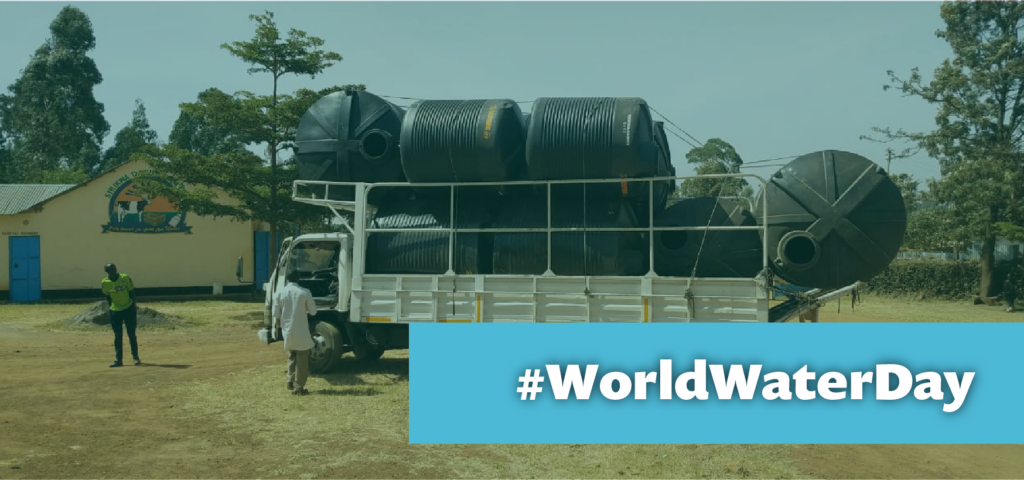
With changing weather patterns and unpredictable rainfall, rainwater harvesting can provide a sustainable source of water for agriculture and livestock production. This is particularly important in dairy farming, as water scarcity and poor-quality water can lead to decreased milk production and health issues in dairy animals. Large water tanks are an efficient method for storing harvested rainwater.
However, financial constraints limit smallholder farmers’ ability to invest in rainwater harvesting tanks for climate adaptation and improved dairy productivity. Lack of access to credit, limited financial resources, and competing household expenses are major barriers to investing in water storage tanks.
Against this backdrop, PxD’s program on Asset Collateralized Loans (ACLs) for water tanks presents innovative financing mechanisms to address water scarcity and liquidity bottlenecks to improve climate resilience and dairy productivity in developing countries.
How dairy ACL works
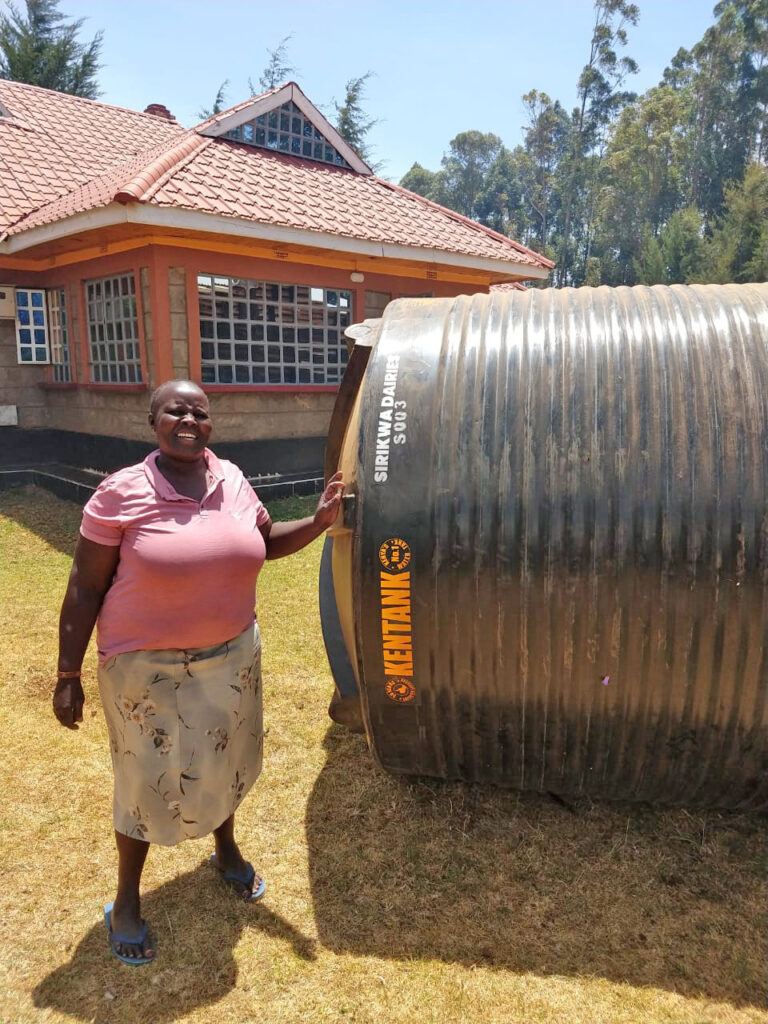
Water tanks pose a unique financing opportunity. They are large and difficult to move, and they retain their market value over time, meaning the assets themselves can serve as the collateral for a loan.
This removes the need for guarantors, which often poses a significant barrier to access to credit. Repayment is made automatically from the milk income earned through milk sales from the farmers throughout the month. If the farmer was to default on the loan, the tank could be resold at close to the original value.
About 1.8 million smallholder farmers depend on dairy farming for their livelihoods in Kenya but a bulk of them are unable to obtain loans from traditional lenders, such as banks, because they do not have the collateral or credit history required.
The ACL approach, therefore, has several advantages over traditional lending methods, which often require extensive paperwork and collateral that many smallholder farmers do not have.
Our Research Project
PxD has been implementing a two-year research project on ACLs for water tanks in collaboration with the University of Chicago’s Development Innovation Lab (DIL) and two dairy cooperatives (Lessos and Sirikwa Dairies) in Kenya’s Rift Valley region.
A previous study (Jack et al., 2019) demonstrated strong evidence that the ACL model for water tanks could improve farming and household health, as well as well-being outcomes among smallholder dairy farmers.
The study, conducted in partnership with the Nyala Savings and Credit Co-Operative Society (SACCO), randomly offered some farmers the opportunity to replace loans with high down payments and stringent guarantor requirements with loans collateralized by the asset itself.
At the end of the study, default rates were extremely low (less than 1%). Milk sales to the cooperative increased by 6-10%. And, because of the increased water supply within households, girls spent 19% less time fetching water, and school dropout for girls decreased by 85%.
This new study aims to evaluate the impact of ACLs for water tanks on economic and household outcomes among dairy farmers in Kenya. The main outcomes of interest include milk production and milk sales, loan performance, dairy farming practices, water use, time use (particularly for girls and women), household welfare, and well-being.
Delivering tanks to farmers
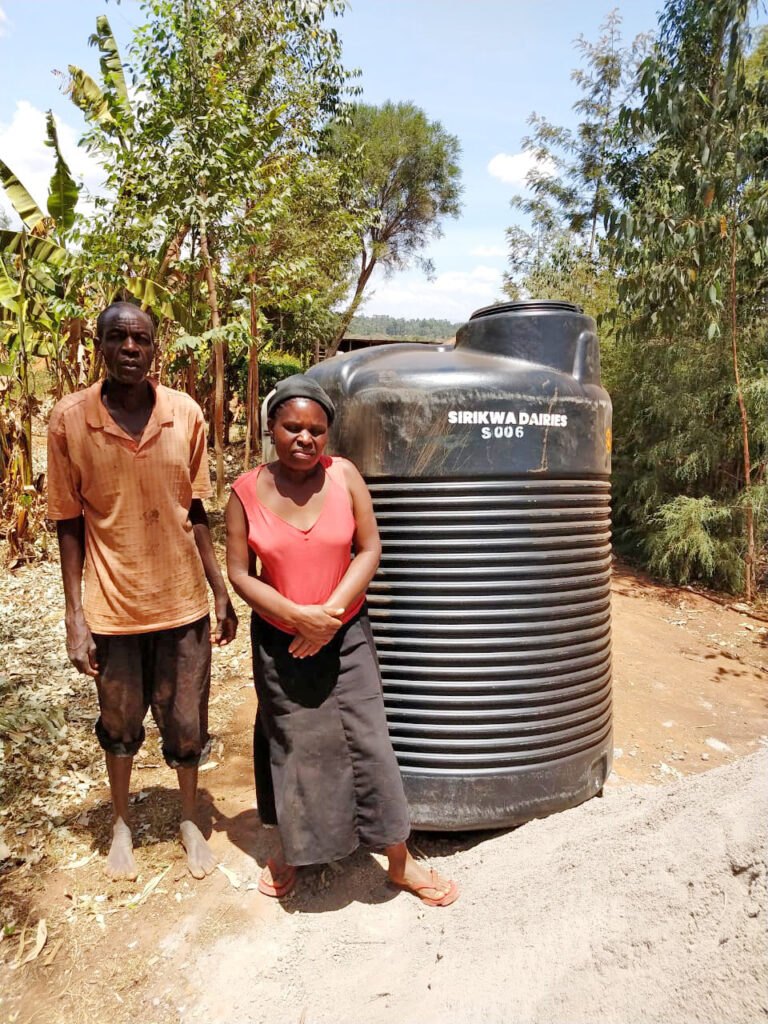
In partnership with the dairy cooperatives, PxD identified farmers that are eligible to receive the water tanks.
Eligible farmers need to pay an upfront deposit (currently 20%) to receive the tank, followed by monthly loan repayments over a two-year period. Farmers can choose between a 2500-liter or a 5000-liter tank depending on their needs. They receive the tanks at their doorstep for free, with a water tap that is ready to install. Starting from January 2023, PxD rolled out the tanks to a small group of 100 farmers. As of mid-March, 15 farmers had received the tank.
Farmers like Philip Too, a farmer from Sirikwa Dairy who has four dairy cows. Most of the people in his village rely on wells for their household water needs but unfortunately, they do not have sufficient water storage equipment. He is one of the few lucky farmers who are connected to electricity and thus he intends to fill his tank with water from a well within his farm using an electric water pump. With the tank, he hopes to have enough water to not only meet domestic needs for his family and livestock but also irrigate his small kitchen garden from which he expects to fetch some income by selling surplus vegetables to his neighbors.
Esther Sambai, a farmer from Sirikwa dairy, decided to get a 5000-liter capacity tank instead of a 2500-liter tank to meet the needs of her household and neighbors. She said, “My well does not dry up and many people in my village get water from my household for free in the morning when I am at home. As you can see, we pump water directly from the well and therefore I decided to get a bigger tank so that I can store enough water for my family and neighbors. With a tank, my neighbors will be able to access water even when I am away. I will also use the tank to supply water to my animals.” Esther has a solar-powered pump but before the ACL for water tanks, she did not have a water storage tank. The ACL has enabled her to finance a tank easily.
Way Forward
In the coming months, we plan to roll out the tanks to additional farmers (with the goal of reaching 750 farmers in total).
From our early interactions, we have learned that several factors influence take-up including time of the year, competing financial needs such as school fees, and low trust in new financial products which could limit farmers’ take-up of the product.
To address this, we hope to pilot low-risk ways of making the ACLs for water tanks more accessible, such as by lowering the deposit or offering a grace period. We will continue to test similar loan flexibility mechanisms until we can define a product that is interesting, safe, and accessible to farmers across contexts and geographies.
PxD is also making its first foray in Kenya into using low-power radio communications for remote sensing by experimenting with water sensors in this study. These sensors will allow us to measure real-time water levels for dairy farmers so that we can correlate supply, consumption, and dairy output. We hope this paves the way for us to explore the use of other sensors (such as those that measure soil moisture or air quality) to improve farmers’ access to real-time information.
Our first few months of rolling out water tanks have given us insight into the potential for ACLs to enhance credit access for productive assets by reducing the financial burden and collateral obligation that smallholder farmers typically face.
We believe this initiative can have a profound impact on farmers and their families in different contexts struggling with access to water, and could be a path not only to increase profits for farmers and the welfare of their livestock, but improve the well-being of women and girls who are those being most impacted by climate change.
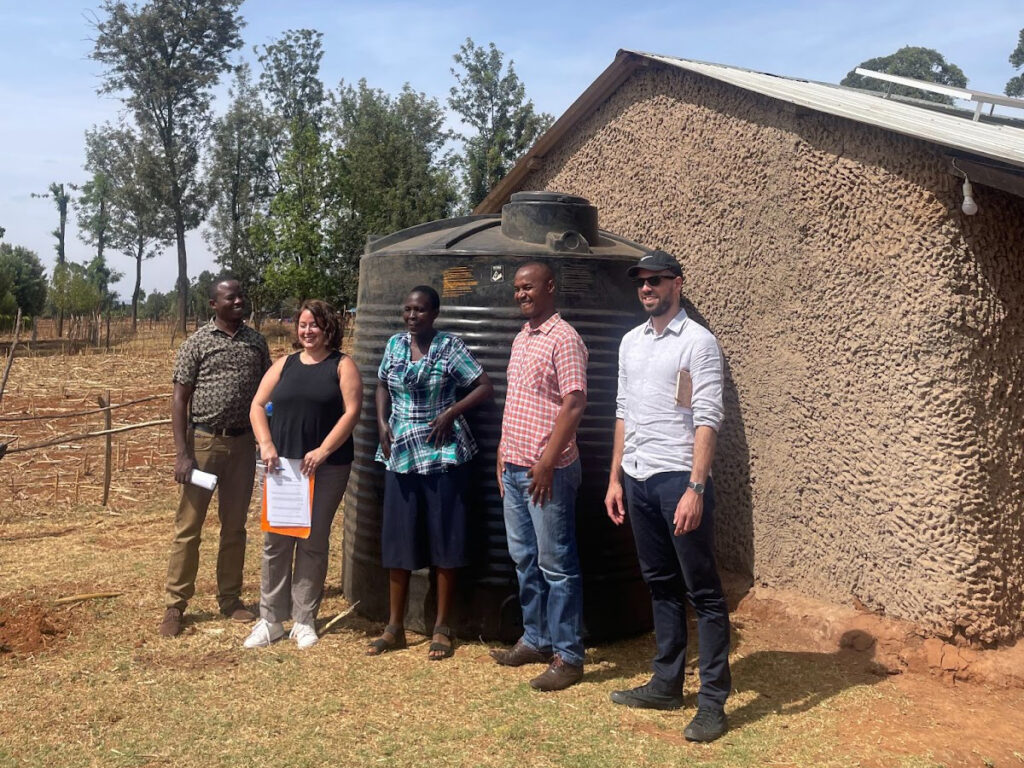
The streets of Mexico City are filled with purple with tens of thousands of women, old and young, who march side by side. They wear purple to highlight the challenges women still face in Mexico.
This event happens in my hometown every International Women’s Day (IWD). Even when I am away from home, these women remind me to use this day to reflect on privilege, equality, gender, and the way ahead.
This year, for IWD, I joined a panel organized by the Food and Agriculture Organization (FAO), the International Fund for Agricultural Development (IFAD), and the World Food Programme (WFP) that focuses on Digital Innovation and Technology for Gender Equality.
During the panel, I shared my reflections about PxDs work, both on the progress I am proud to be a part of at PxD and the opportunities for us to do better in the future.
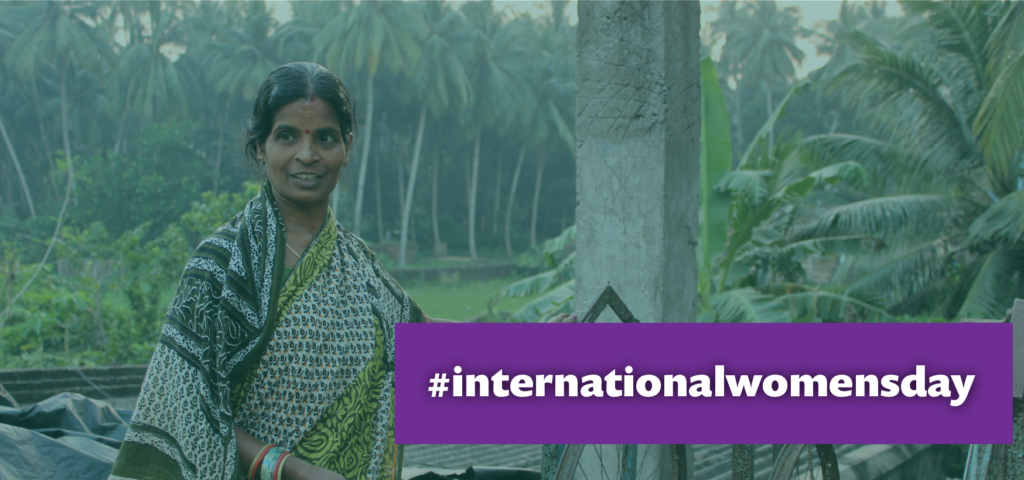
Here are a few of the things that I am proud to see at PxD:
We have better information on use and engagement by gender. We have improved our monitoring systems to have more information on our users, their engagement, and feedback. One of these improvements was to start collecting more information on gender, allowing us to understand women’s engagement better and incorporate that information into our design and decision-making processes.
We have developed services and content focused on women’s needs. Kitchen gardens are small plots of land where fruits, vegetables, and spices are grown for home consumption. Soon after launching a service focused on kitchen gardens, we realized that women often prefer the content on kitchen gardens over the general crop service. We think this is linked to the fact that they often have decision-making power over kitchen gardens but rarely over the primary crops that the family grows.
We have acknowledged that, as an organization, we are not yet gender experts, but we can partner with the best organizations in the sector to learn and improve our services. For example, our current partnership with SEWA Federation in Gujarat supports the delivery of crop advisory to women registered with the federation. These women seem to have a higher listening rate (almost 10 pp more) for the voice-based advisory messages compared to the average for all our registered farmers. The listening rate refers to the proportion of our calls that users listen to before hanging up. This sign of high engagement shows our content is relevant to their interests.
We have found a pathway to reaching more women by targeting activities they control, like dairy farming. Even though most of our users in Pakistan are male, 96% of the livestock and dairy program users are female. That program aims to equip rural women with better information about effective home-based livestock rearing and management, timely vaccination, and artificial insemination. By targeting dairy, a means of production they control, we can directly support them. Women are also heavy users of our dairy service in Kenya, where around 51% of users in our pilot were female.
Here are some opportunities for us to do better in the future:
Users of PxD services are still largely men. PxD often relies on government databases to identify potential users, and these databases tend to have a large proportion of male farmers. We have explored a few alternatives to increase the number of female users, but we need and want to do more. We will continue to explore partnerships and identify additional sources of information or alternative ways to reach women. As of the last quarter of 2022, we have increased the proportion of female farmers to 28%, which is a good improvement from previous years, but we still have room to grow.
We need to improve our impact on each woman who uses our service. This year IWD’s campaign highlights equal opportunities are not enough. We must continue to think about differential needs and services by gender, remembering that while having more women in each service is a goal, developing and implementing services tailored to their specific needs is also a priority. We have been successful to date with programs with kitchen gardens and dairy. We should continue to expand these services and identify similar opportunities that have the potential for a significant impact.
We need to design more services for women. While adapting our services to women and adding more women farmers to existing services helps address some of the digital divides, we need to understand better the unique constraints women in agriculture face, and their information needs, and identify effective ways of reaching them. For example, we have been working with the SEWA Federation to understand whether women’s groups might be effective ways to reach women, many of whom may not own a phone, to understand how information flows within these groups; and how technology may be able to address some of the informational asymmetries. We’re also pursuing large-scale partnerships with women’s groups in India, for example, through discussion with national and state-level rural livelihood missions to enable us to generate a wealth of insights and learnings on designing services that can effectively reach women in agriculture and meet their needs.
As we continue to grow as an organization and design and implement new programs, I look forward to learning more about how to serve female farmers better and incorporate those learnings into services that have the most significant possible impact on their livelihoods while considering the unique challenges that females face.
Punjab means “five rivers”, and those five rivers are the reason that the Punjab region in Pakistan is the country’s bread basket. Tomoko and I were in Punjab last week visiting the PxD Pakistan country team. As many of you will know, PxD in Pakistan is housed within a local economics research institute, CERP, a partnership that has enabled us to be more effective and flexible.
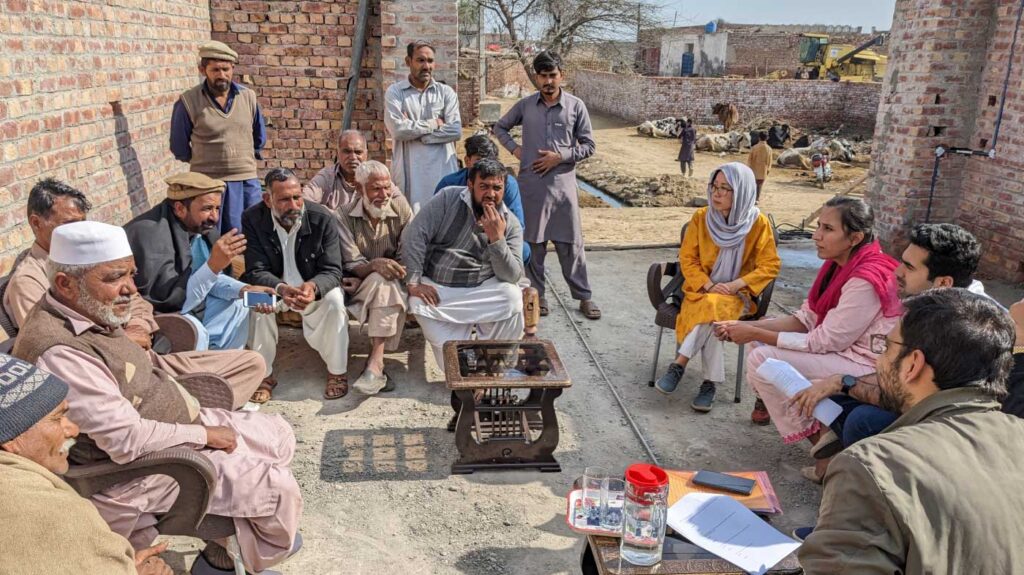
This week much of our attention has been on smallholder rice production. The staple food in Pakistan is of course wheat (for roti), but rice is a major crop for both domestic consumption and export. (We were in town at the same time as the IMF delegation, negotiating a package of macroeconomic reforms to stabilise the economy, so those export earnings are important right now).
Punjab is famous for its basmati rice, a variety much prized for its aroma, fluffiness and grain length. It is very popular in traditional dishes like biryani and pulau. We visited Kala Shah Kaku Rice Research Institute, established in 1926, where basmati rice varieties have been developed since the 1930s. Farmers in Pakistan typically grow wheat in the Rabi season and then many grow rice in the Kharif season, especially in the basmati belt in Punjab. The yield of basmati rice is around half as much per hectare as hybrid rice varieties, but it sells for around twice the price, so generating similar revenues and broadly similar net income per hectare. (An exciting development on the horizon is the prospect of hybrid basmati rice that may have a much higher yield while retaining much of the quality for which basmati rice is famous.)
Many of the people we met were keen to stress that Pakistan, rather than India, is the home of basmati rice. I’d be very glad if the rivalry between these two great nations were confined to arguing about the origin of basmati rice and, far more importantly, their relative prowess in cricket.
Pakistan’s farmers produce on average around 4 tonnes of rice per hectare, about the same as in India. In China, the yield is 7 tonnes per hectare and in Australia 10 tonnes per hectare. The yield gap (that is, the gap between what farmers produce and what they could produce with the land and other inputs available to them) is estimated to be about 50% – about 3.5 tonnes per hectare – for basmati rice, and closer to 60% – 6 tonnes per hectare – for the higher yield but lower price varieties. In other words, farmers could, in principle, at least double their yields. So what is holding them back?
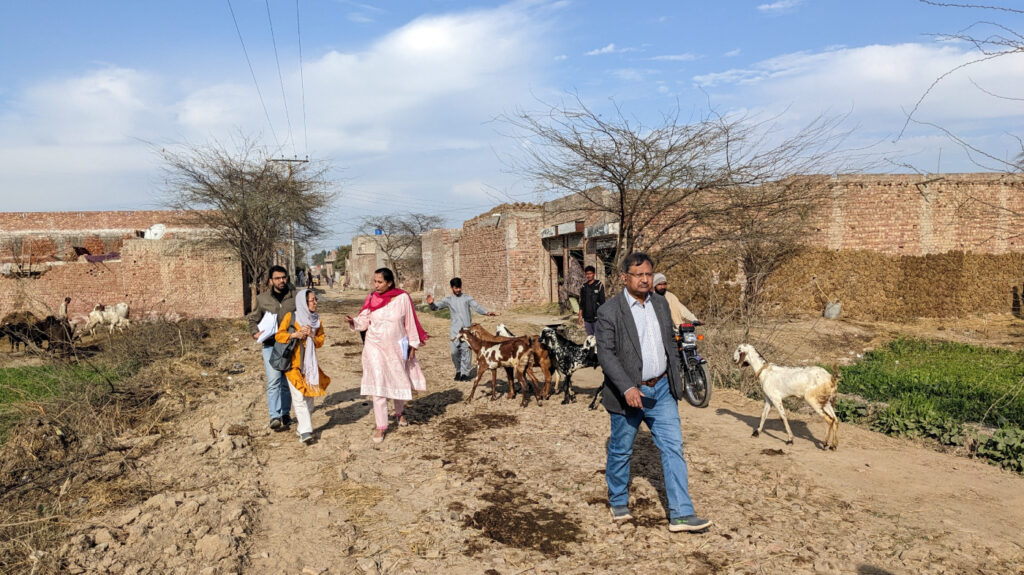
You would expect farmers to be more interested in increasing their profit than their yield, so one possible explanation – in theory – could be that the additional inputs are too costly, and the value of the extra output does not justify the investment. In that case, it would be rational for farmers not to increase their output this way. But that doesn’t seem to be the problem. The additional cost of the recommended inputs, at market prices, is small relative to the price that basmati farmers could get for the roughly extra 3-4 tonnes per hectare that they could be producing. Despite extra input costs, the extra yield on this scale would lead to much higher profits – perhaps multiples of profits now being earned. If you are doing only a little better than breaking even, then moving to a reasonable surplus could mean a transformational increase in net income.
So what is getting in the way? We spent two days in villages outside Lahore talking to farmers, extension agents, and private and public sector experts to try to get a better picture.
My main take-away is that it seems that expensive credit for agricultural inputs and low prices paid by middlemen (called aahrtis) leaves farmers with little surplus. Farmers are unwilling to take on a large, expensive debt which – if the harvest is bad – they may not be able to repay, especially when they know that a big chunk of any profit, if the harvest is good, will go to the middleman. So they stick to limited use of inputs, which gives them lower yields and less debt and thus lower risk. Thus it is the cost of credit, and the associated risk, rather than the cost of the inputs themselves, that stops them from investing more.
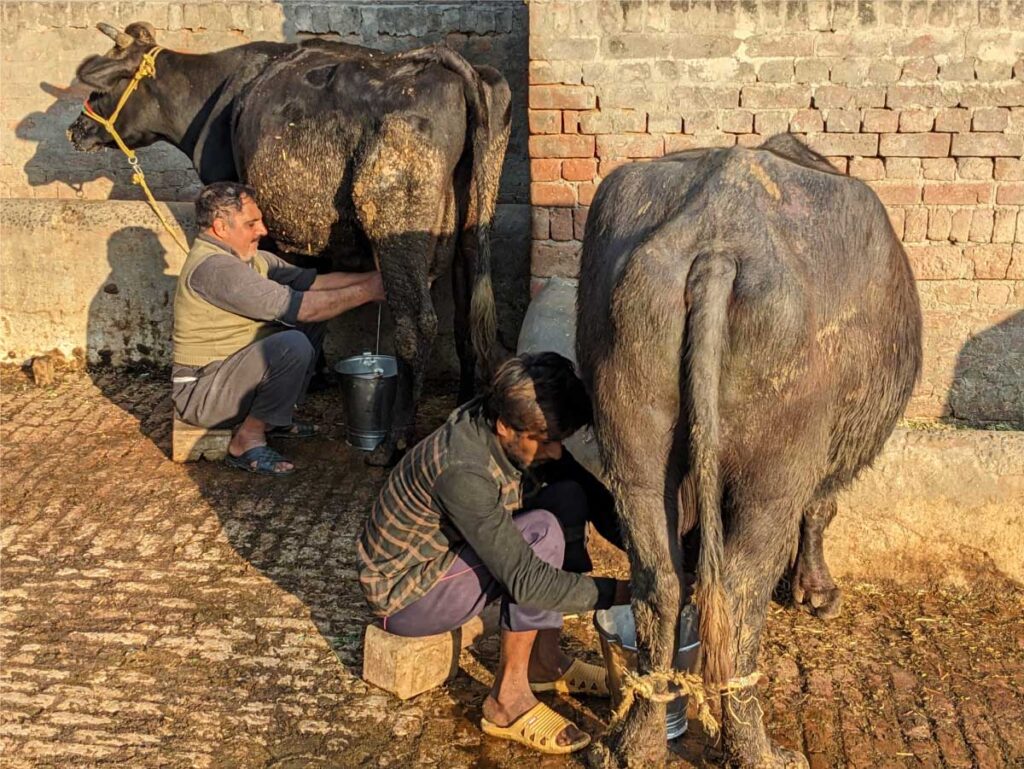
I’m conscious that we met farmers close to Lahore, who are relatively well-off, and who are already in contact with extension services. So we should be careful about drawing too many conclusions. Based on these few conversations with an atypical group of farmers, I find it hard to convince myself that there are very many practices that farmers could adopt that they do not already know about. That said, there may be some value to encouraging practices that cost the farmer little or nothing to implement – or which save inputs such as using the right amount of urea – for example by issuing timely reminders. But it looks as if the larger gains would come if we could find a way to reduce the risk of increased investment in inputs, reduce the cost of credit, provide high-resolution weather information, or perhaps improve planning and coordination in the use of scarce machinery or casual labour.
It is harder to notice what is missing than what is in front of you. As you may see from the photos, we did not meet any women farmers. We met a female scientist at the rice institute, but everyone else we spoke to was a man. In every conversation, farmers were routinely and unthinkingly referred to as “he”. Yet we know that women provide a substantial part of labour in agriculture, and are hugely affected by all the decisions that are made. If we want to understand what it would take for farmers to adopt practices that would increase their yield and their incomes, we are likely to learn a lot by talking to women too.
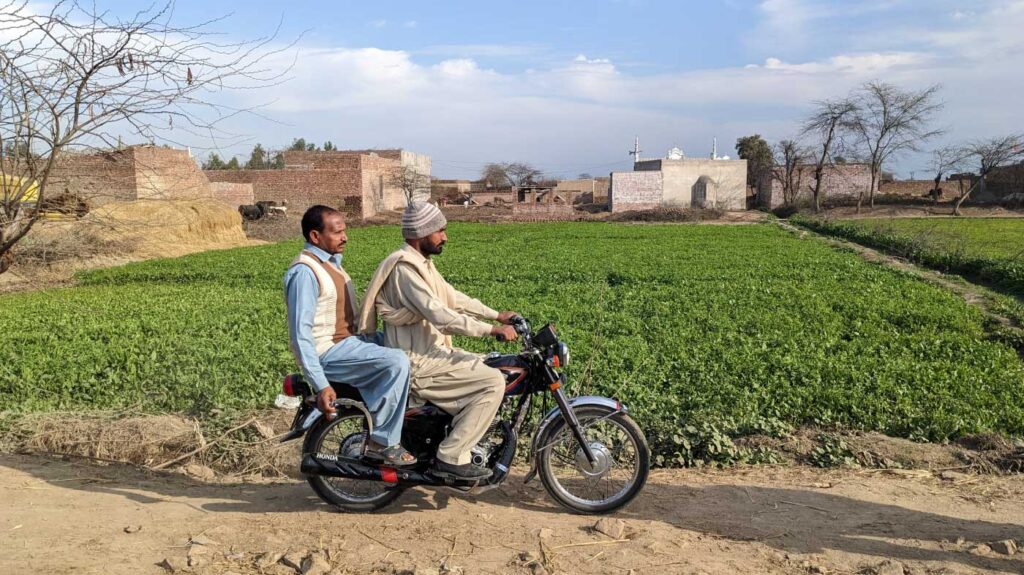
I leave Pakistan optimistic but uncertain. Optimistic because the opportunities are huge for large increases in yield and potentially transformative increases in farmer incomes. The constraints are real, but there may be solutions that have a low marginal cost per farmer and so would be hugely cost-effective at scale. Uncertain because we do not yet have enough information to arrive at robust ideas for higher-impact services that we could design and test.
I want to thank Adeel, and all the team, for giving up so much of their time and energy to host us – including taking us to the old Walled City of Lahore to have dinner overlooking the famous Badshahi Mosque (Mosque of Kings) and the Lahore Fort (Shahi Qila in Urdu), an ancient citadel of the Mughal Empire. I look forward to returning to Pakistan soon and hope to combine my next trip with some tourism in your beautiful country.

When disease and a heatwave, followed by devastating floods ravaged Pakistan’s Punjab province, PxD’s LMAFRP digital information service, which we implement in partnership with the Rural Community Development Society (RCDS) with support from the International Fund for Agricultural Development (IFAD), assisted women livestock farmers navigate new and unprecedented challenges. This International Day of Rural Women, we highlight the important role women play in Punjab’s rural farming economy and our work to promote information to enhance more productive and resilient livelihoods.
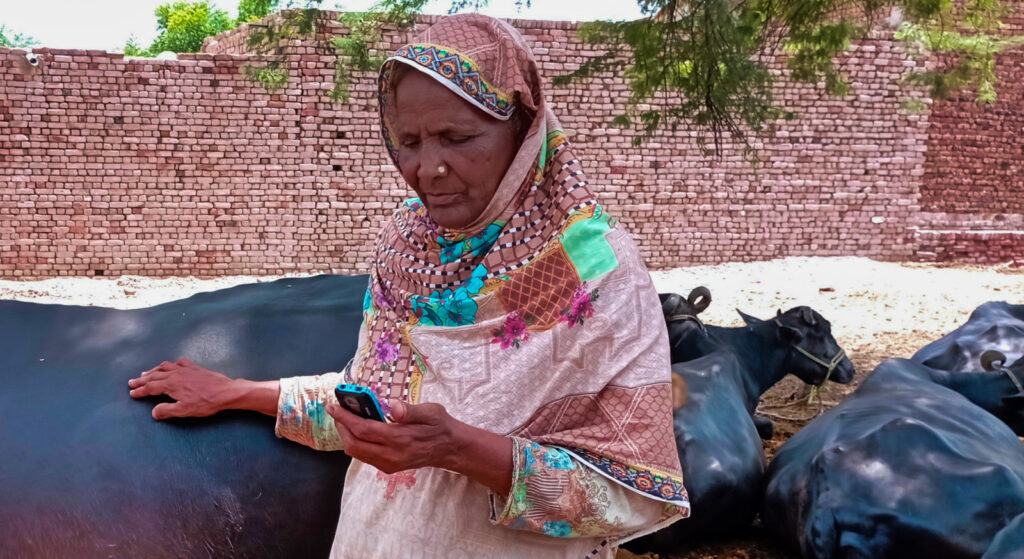
Introduction
Livestock husbandry and livestock-related products (dairy, meat, leather goods, etc.) constitute an important sub-sector of Pakistan’s agriculture sector: Pakistan is the fourth largest milk-producing country in the world1Sattar, Abdul, “Milk Production in Pakistan” PIDE Blog, pide.org.pk/blog/milk-production-in-pakistan , and the share of livestock products in the generation of foreign exchange is approximately 13%2Government of the Punjab, “Livestock Contribution” , livestock.punjab.gov.pk/livestock-contribution. As is the case in many smallholder economies, in Pakistan, women are largely responsible for the care of livestock and for the production of many livestock-related products, particularly dairy3Ibid..
In rural areas, livestock plays an outsize role in livelihoods, with the Punjab provincial government estimating that “livestock is an integral part (30-40%) of the livelihood of about 30 to 35 million rural farmers”4Ibid.. Livestock-related products, such as butter, eggs, meat, and animal fats (oils), contribute important nutrients for all households – rural and urban – and play a critical role in meeting the nutritional needs of rural children. Further, livestock contribute an important source of continuous income which can sustain poor rural households between seasonal crop-related revenues, and insulate them from shocks5Ahmad, Tusawar Iftikhar and Tanwir, Farooq, “Factors Affecting Women’s Participation in Livestock Management Activities: A Case of Punjab-Pakistan”, mpra.ub.uni-muenchen.de/93312/1/MPRA_paper_93312.pdf..
For these reasons and more, supporting the development and improvement of livestock farming can have a considerable impact on improving the livelihoods of Pakistan’s rural population, and can impact the livelihoods and status of rural women. We believe significant gains can accrue to rural farming families through the promotion of best practices to women. Improved practices can improve yields and minimize losses, leading to increases in income from livestock farming.
Many rural women are unaware of best practices that can optimize outputs associated with livestock, and access to information and economic opportunities can be constrained by cultural and geographic barriers. As documented elsewhere on this blog, digital extension services offer cost-effective and easily scalable solutions with very low marginal costs. In rural Pakistan, where many women rarely leave their homesteads, the portability of digital information offers additional advantages for navigating geographically and culturally hard-to-reach spaces.
Geographic and cultural constraints to attending in-person RCDS livestock training sessions were exacerbated by social distancing introduced to mitigate the COVID-19 pandemic. RCDS’s in-person activities were suspended in the initial months of the pandemic, but the utility of advisory information increased as rural households navigated new challenges in a time of escalated economic stress. It was at this time that RCDS and PxD initiated a partnership to deliver advice to livestock-rearing women in rural regions of Punjab province in Pakistan. This collaboration, supported by IFAD, provides customized and actionable digital information to livestock-rearing women. Combining PxD’s experience in delivering digital extension services to Punjabi farmers and RCDS’s extensive local knowledge and expertise, the service draws on demographic insights, and cultural practices to deliver information that is accessible, comprehensible, and actionable for recipients.
The resultant digital advisory service has proven to be an effective, cost-efficient, and scalable supplement to in-person training, and is now extended in the absence of COVID-19-related social-distancing constraints. The service demonstrated new advantages when unfamiliar disease- and climate-related threats subsequently impacted rural households.
The Service
RCDS’s experience and local trust in their services have been integral to the success of the initiative. Over the past two decades, RCDS has partnered with local, federal, and international institutions to build a significant rural network to promote and implement development programs to assist poverty-stricken segments of society in rural areas of Pakistan.
Advisory content was developed in partnership with local livestock consultants who were well-informed about local livestock issues and output-increasing best practices. The advisory information distributed by the service covers a wide array of topics, including disease identification, information about and access to vaccinations, disease prevention and remedies, practices to increase milk yields, and guidance on protecting livestock against climate-related shocks.
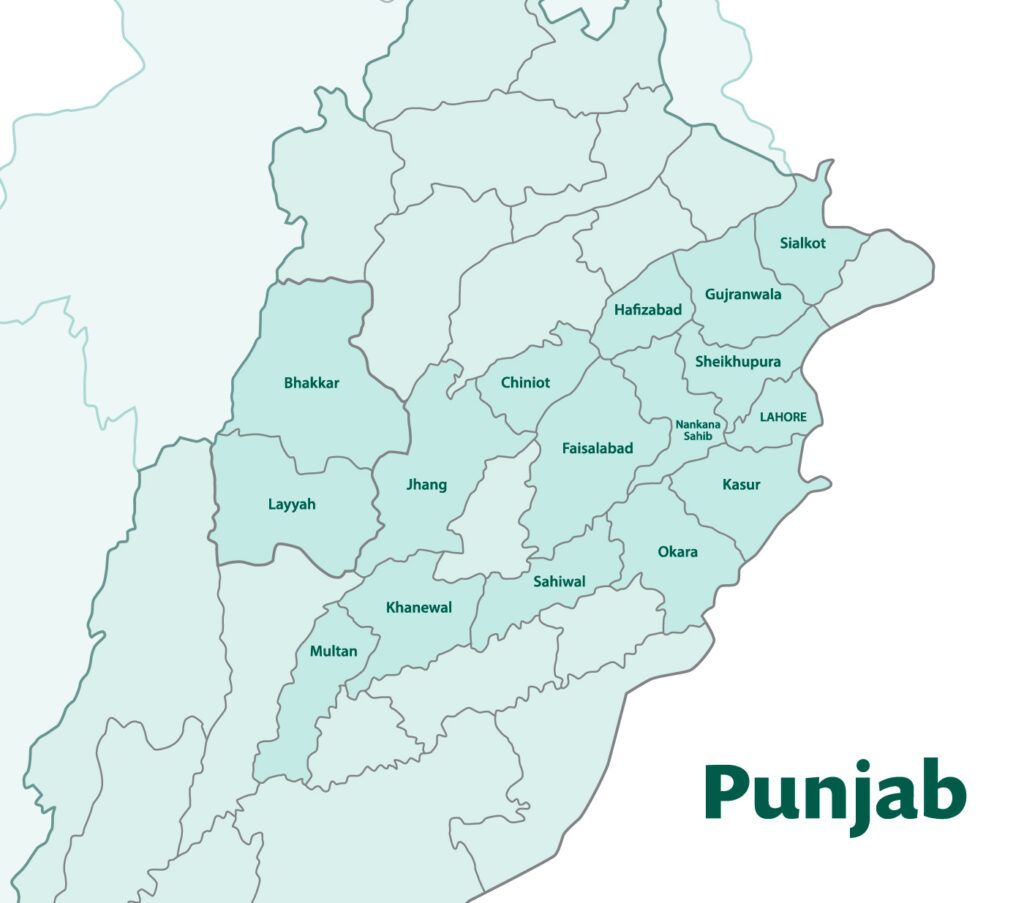
After conducting a baseline survey to systematically understand the informational needs of women farmers in four districts in Punjab, and the development of advisory information, PxD piloted digital services among 3,160 rural women associated with RCDS. The four districts, in which the pilot was concentrated, are among the poorest districts of Punjab, all of which are located in the south of the province. Given the success of the initial pilot, the service has subsequently been expanded to more than 50,000 livestock-rearing women in 16 rural districts of Punjab.
One of the key components that PxD assessed during the initiative was the extent of knowledge retention by participating women after they received the advisory. Pilot testing in the early stages showed that the advisory information was not only useful but was also retained for a significant period after it was delivered.
RCDS maintains a dataset of women who have either attended in-person sessions of livestock advisory or shown an interest in livestock advisory or have taken a microfinance loan for livestock farming. This data, and its quality, were instrumental in helping PxD deliver the advisory directly to the women via their phones. Furthermore, the data also contained the districts in which each woman resided. This was used to help decide in which of the two local languages – Punjabi and Saraiki – the advisory would be conveyed.
Advisory information is delivered through a voice call. A text message is sent 24 hours before the call to alert users that they should expect a call the next day. This is done to ensure that the advisory is received by women. A barrier highlighted by the baseline survey was limited access to mobile phones on the part of women in the region. Cultural and financial constraints make it far more likely that men have primary access to cell phones. Hence, the time allotted for the voice calls is set at a specific hour in the evening, so that the call is received in the evening when the family is no longer busy with agricultural activities, men are more likely to be home, and when family members can collectively listen to the advisory in their homes.
The voice call has local cultural music layered in the background, to assist the participant in developing trust in and comfort with the message. The information is delivered in the local dialect – Punjabi or Saraiki – to enhance understanding of and familiarity with the recorded message. Further, listeners are told that the advisory is from RCDS since it is well-known as a trusted organization in these regions. As a general protocol, to improve pick-up rates when the voice call is unanswered, another call is placed after a 15 to 30-minute interval.
Lumpy Skin Disease
A significant advantage of digital extension is the ability to send timeous information. This is particularly valuable to address and prevent viral diseases that can have a drastically negative impact on the well-being of the livestock.
In April 2022, Pakistan saw a viral outbreak of lumpy skin disease in cattle. The disease was transmitted between cattle via blood-feeding insects. The disease has a high virulence and fatality rate and killed thousands of cattle in the country.
A significant hurdle that seriously hindered timely prevention and actions to curtail the impacts of the infestation was the lack of baseline knowledge and awareness of the disease. Moreover, misinformation was rife, with misplaced rumors about negative effects of vaccines abounding. Many people mistakenly believed that it was the vaccines that were causing deaths among animals, when animals that had died were either already infected with lumpy skin disease, or were generally sick and should not have been vaccinated at the time.
Understanding these knowledge gaps, PxD and RCDS collaborated to provide timely information about the infestation. Initial infections were observed in the southern part of the country and slowly spread north towards Punjab province, where our users reside. PxD started providing information about lumpy skin before the disease had become widespread in the province.
Our farmer-users were given information about the disease and its virulence, how it is spread, and traditional preventative measures. Following that, to increase the survival rate of infected cattle, users of the service were advised to vaccinate their cattle as soon as vaccines became available. Participants were also informed about how to identify early signs of the disease on the animal.
Anecdotal feedback received by RCDS in the field suggests that the messages were very useful. Users with whom PxD surveyed reported that in many instances they were able to avoid fatal infections in their animals due to timely vaccines, even if their animals did get infected.

The Floods
In the summer of 2022, Pakistan witnessed firsthand the severe impacts of climate change. In March and April, the country experienced a crippling heat wave, followed by a record-breaking monsoon season in Punjab, Sindh, and Balochistan spanning June, July, and August. An unparalleled monsoon, coupled with unprecedented melting of glaciers in the north due to the initial heatwave, led to extreme flooding in rivers that flow from the north of Pakistan to the south. The floods are estimated to have impacted at least one-third of Pakistan, including the livelihoods of 33 million people.
Prior to the floods, the extreme heat waves had contributed to a general belief that floods were imminent. To counter the threat, the PxD team in Pakistan worked with RCDS to preemptively identify areas prone to flooding, and prepare advisory messages with useful information about managing floods, and adaptive strategies to protect assets and livelihoods.
A major problem with livestock is their slow mobilization, making them and their rearers prone to becoming flood victims. Timely warnings and regular updates via voice call advisory messages provided participants with information for ensuring the safety of their livestock during the floods. PxD and RCDS made use of their existing program to deliver instructions, warnings, measures, and assistance via voice call messages, to inform participating women and their families about floods and ways to protect themselves and their livestock.
Meeting today’s challenges
The advisory service designed by PxD, and delivered in partnership with RCDS, provided an effective method to deliver timely information to livestock farmers. Due to its effectiveness in the regions where it was being delivered, the advisory service was extended to address other unforeseen challenges, such as the virulent lumpy skin disease, and flooding.
In addition, our project has demonstrated the core strengths of digital communication: it is cost-effective, scalable, and capable of reaching regions and communities that are disconnected or hard to access due to difficult terrain, long distances, or cultural constraints.
Our advisory content was designed to deliver information in a manner that does not require the recipient to have prior knowledge, or education to understand the subject. The use of familiar dialects and carefully crafted messages made the information accessible, easy to understand, and ultimately very effective.
PxD aims to further extend the benefits of digital communication to support other low-cost interventions among rural communities of Pakistan. More specifically, feedback received from users has prompted PxD to further our partnership with RCDS to envisage interventions to support digital veterinary services. We are motivated to continue to harness the power of digital communication to facilitate more productive and resilient livelihoods in rural communities of Pakistan.
Precision Development (PxD) has completed a landscape analysis to more systematically understand the challenges faced by users of the Coffee Krishi Taranga (CKT) service, with a focus on three core areas, namely, sustainability, market linkages, and gender. This work was funded by a grant from the Walmart Foundation.
As part of the landscape analysis, we conducted multiple rounds of farmer interviews, an extensive review of the literature, an analysis of our existing farmer database, and interviews with sectoral experts. In this blog, we share some key findings and information about what we’re looking to do next.
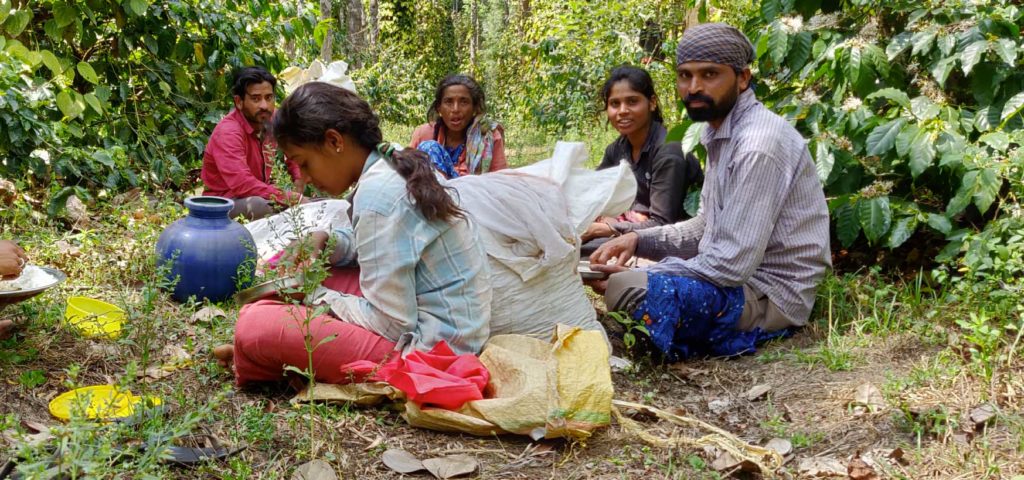
Coffee Krishi Taranga
Since August 2018, PxD has partnered with the Coffee Board of India to provide the CKT service to coffee growers. The CKT service is modeled on PxD’s flagship two-way Interactive Voice Response (IVR) service, which comprises an outgoing service that provides regular advisory to growers on their mobile phones and an inbound hotline that farmers can call to access free information services, including market-related information, and leave messages to be answered by agronomists. As of April 2022, the CKT services approximately 74,000 coffee growers across the states of Karnataka, Tamil Nadu, and Kerala. The team plans to expand the reach of the service to growers in Andhra Pradesh soon.
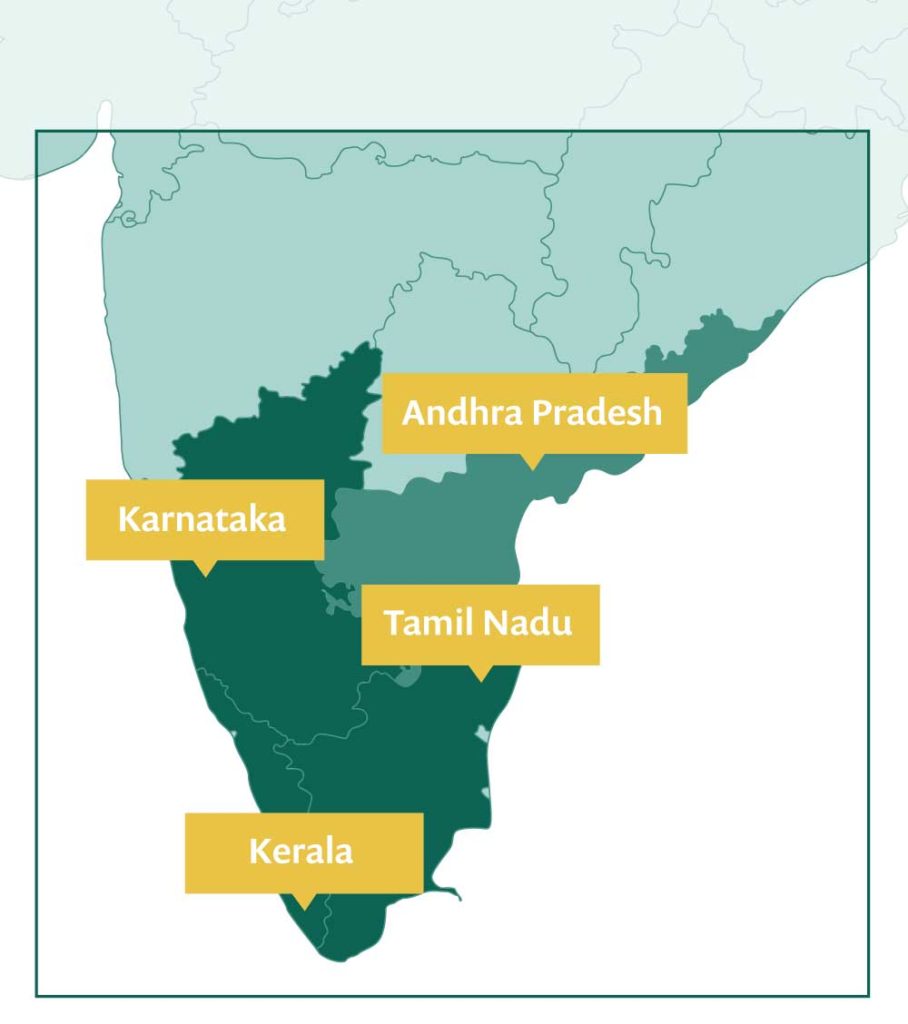
Key findings
Sustainability
Coffee growers in India face multiple risks linked to weather unpredictability, a challenge that has been exacerbated by climate change. Coffee is a sensitive crop, and heat and rainfall are widely considered to be the two most important factors for coffee growth1Haggar, J. and Schepp, K. (2012). Coffee and Climate Change Impacts and options for adaptation in Brazil, Guatemala, Tanzania and Vietnam. National Resources Institute Working Paper Series: Climate Change, Agriculture and Natural Resources, [online] No. 4, pp.1–50. Available at: https://www.nri.org/publications/working-paper-series/4-coffee-and-climate-change/file [Accessed 14 Sep. 2021].. In farmer interviews conducted in September 2021, 92% of farmers (N=83) said they had faced a weather-related challenge in the past year2Haggar, J. and Schepp, K. (2012). Coffee and Climate Change Impacts and options for adaptation in Brazil, Guatemala, Tanzania and Vietnam. National Resources Institute Working Paper Series: Climate Change, Agriculture and Natural Resources, [online] No. 4, pp.1–50. Available at: https://www.nri.org/publications/working-paper-series/4-coffee-and-climate-change/file [Accessed 14 Sep. 2021].. Weather can negatively impact the cultivation of coffee in a variety of ways, including crop damage at sensitive times such as blooming3Pokiya, T. (2021). Interview: Agronomist, PxD. 16 Jun. , increased incidence of pests and disease, increased soil erosion, and more.
What are we doing?
One obvious solution to mitigate the risks of weather variability is weather forecasts, in particular providing customized weather forecasts or real-time weather information, potentially coupled with relevant agronomic recommendations. However, access to high-quality forecasts is limited. In our farmer interviews, only 16% (N=73) said they have access to forecasts4 Krishi Taranga coffee growers (2021). Qualitative farmer surveys: Round 5. 24 Sep.. Our team is currently in the process of putting together a pilot to test the impact of providing customized weather forecasts on key agricultural practices (if you’re interested in learning more about PxD’s weather-related learnings, check out this recent series of blogs).
“The weather imbalance leads to severe black rot and we cannot use spray at the right time.”
Interview with D.S. Sathish, Basrikatte, Chikmagalur
The increase in average temperature and erratic rainfall also exacerbates risks associated with certain pests5 Watts, C. (2016). A Brewing Storm: The climate change risks to coffee. [online] The Climate Institute, pp.1–14. Available at: https://www.juntospelaagua.com.br/wp-content/uploads/2016/09/Pesquisa-sobre-caf—The-Climate-Institute.pdf [Accessed 14 Sep. 2021].. The impact of climate change on pests varies, but overall heavy rain and warmer temperatures are likely to increase the conditions in which several pests thrive. These pests can cause varying levels of damage — some can be devastating, resulting in crop losses of up to 70% if not treated timeously and effectively.6Machenahalli, S., Ranjini, A. P., Madhu S., Giri, Sudha M., Daivasikamani, S. and Surya Prakash Rao N. (2019). Disease of Coffee during monsoon season and their management. [online] Planter’s World, May, pp.4–7. Available at: https://krishi.icar.gov.in/jspui/bitstream/123456789/23682/1/coffee%20disease%20during%20monsoon.pdf [Accessed 14 Sep. 2021].
To explore ways to provide more targeted and actionable recommendations for pest management, we ran an A/B test in November 2021 that looked at the impact of sending multiple reminders on farmers’ knowledge and adoption of high impact practices. We focused on the treatment of white stem borer, an increasingly common pest for coffee growers in India. The results from this test will be shared shortly!
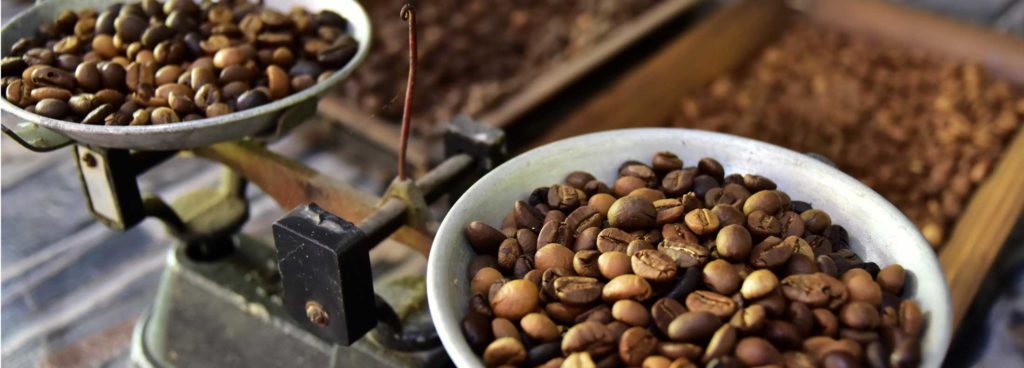
Markets
Smallholder coffee growers sell their produce in fragmented and exploitative local markets. A survey from Chikmagalur and Hassan districts (Karnataka) found that over 90% of growers sold their produce at the farm gate7 Babu, P. (2019). Value Chain Upgrading Strategies for Integration of Indian Small Coffee Growers in Global Coffee Value Chain. Economic Affairs, 64(4).. In our interviews, we found approximately 50% of farmers (N=140) sell their coffee to local traders or markets8Krishi Taranga coffee growers (2021). Qualitative farmer surveys: Round 1. 6 Jul.. There are several reasons why these selling conditions are less than ideal. This includes a lack of infrastructure: smallholders, who deal with relatively small amounts of coffee, usually sell directly to a local trader or agent who pays them on the spot and bears the costs of transporting the coffee to the curing agent. This is where smallholders often lose value on their coffee as local traders set the price for the farmers’ produce.
Another concern is high price variability and lack of transparency. Local traders set coffee prices according to international coffee trends. When buying from farmers on the ground, this price is adjusted based on the quality of the product, which is measured by moisture and out-turn tests. However, the degree to which prices are adjusted based on these metrics is not always clear, leaving farmers feeling frustrated.
“Traders will not buy coffee at existing coffee prices. When traders provide information about prices [they say] it will be more, but [when it comes to] selling the coffee, traders fix a certain [lower] rate and give the unnecessary reason that the moisture content is not good.”
Interview with A.G Nannaiah, Virajpete, near Madikeri
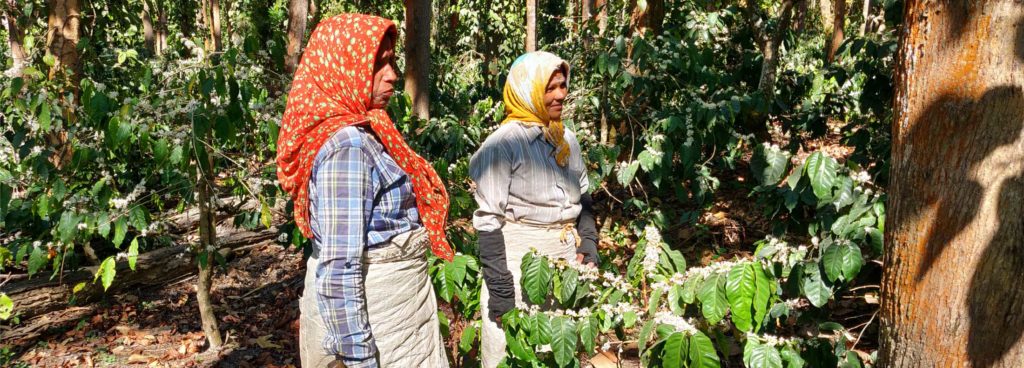
What are we doing?
As part of the CKT hotline, we offer a free price feature which farmers access to listen to daily local and international price information. This is our most used feature, indicating interest in price information. However, overall usage of the hotline is low. We are currently exploring alternative ways of delivering price information to our farmer base, in the hope of reducing frictions and increasing the use of market price tools and information. Lines of relevant inquiry include exploring the use of WhatsApp and SMS to provide price alerts.
To explore ways of reducing price variability, which contributes to income volatility and uncertainty, the PxD team is running a market linkages pilot with the Sustainable Trade Initiative (IDH) in Karnataka. IDH will facilitate contracts between interested buyers and smallholder growers, in which buyers commit to purchasing produce (granted it meets certain quality conditions) at a fixed price. PxD will support growers in meeting these conditions by disseminating relevant agricultural information.
Gender
“My wife visits the estate whenever it is necessary, for example if I am away from the station she looks after things, and after the harvest and the coffee is dried, she weighs it and keeps a record of the quantity of coffee available after it has dried.”
Interview with Virajpete Madhayya, Madikeri
As per India’s Census 2011, coffee plantations were major employers of women workers in Karnataka; out of a total of 480,000 average daily workers employed in coffee plantations, 62% were women. Women appear to be employed for specific activities such as coffee picking, weed management, and applying manure and chemical fertilizers 9Joy, C.V. (2004). Small Coffee Growers of Sulthan Bathery, Wayanad Kerala Research Programme on Local Level Development Centre for Development Studies Thiruvananthapuram. [online] Centre for Development Studies, Kerala, India: Centre for Development Studies, pp.1–43. Available at: http://www.cds.ac.in/krpcds/publication/downloads/83.pdf [Accessed 29 Oct. 2021].. In our interviews with women, we found that women are heavily involved in specific coffee-related activities, including weeding and coffee picking. While women are generally not primary decision-makers for most activities, they appear to be included in the decision-making process. We also learned that women are often part of community groups including self-help groups like “Swasahaya Sangha” (for more information, see our blog post on women’s groups).
What are we doing?
We would like to explore the role of women’s groups and whether these can be leveraged to increase engagement with, and provide relevant support to, female farmers. Evidence from our other programs and the literature suggests that women can increase their collective knowledge and engagement through participating in community groups. The fact that many women in our service are generally involved in day-to-day decision-making suggests that there is room to cater specifically to the areas in which women work. This includes exploring value chains adjacent to coffee cultivation where women may have more involvement, for example, intercrops like spices.
Looking forward
The landscape analysis helped our team gain a broader understanding of the range of challenges and opportunities that exist within the coffee sector in Southern India. In doing so, we have been able to strategize and set evidence-based priorities. This includes focusing on addressing weather-related risks through a pilot to test the impact of providing customized weather forecasts to coffee growers, and a market-focused pilot with IDH.
At the same time, we are also scaling our program with the support of the Walmart Foundation. This includes expanding to another coffee-growing state, Andhra Pradesh. Coffee growers in Andhra Pradesh are different from those in Karnataka, as they are primarily based in tribal regions and practice more traditional farming. We are excited to learn more about coffee growers in this region and adapt our existing service to address their unique information needs.

Precision Development (PxD) recognizes that the informational needs of poor women farmers, and the challenges they confront, are unique. As a consequence, our services must be tailored to reach and be relevant to the needs of women users. Driven largely by the onboarding of women active in livestock-related activities, the number of women farmers active on platforms built by PxD increased by approximately 46% over the course of 2021. This included the onboarding of over 150,000 women farmers to our Ama Krushi (AK) service, which we deliver in partnership with the Government of Odisha, India. As we mark International Women’s Day, we reflect on efforts we have made to improve our understanding of gendered divisions of labor and bargaining power within Odishan smallholder households, and steps we are taking to assist women farmers make more informed decisions.
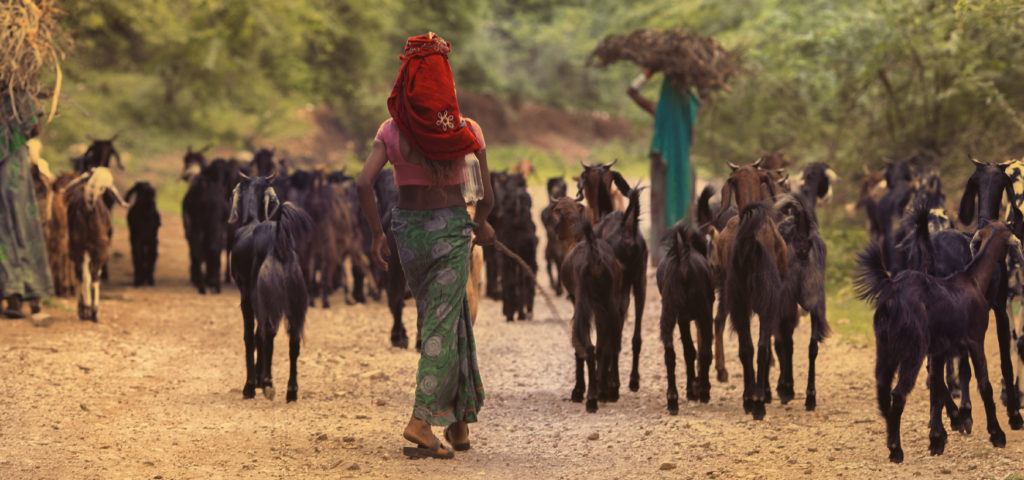
Scoping work undertaken by PxD suggests that women farmers spend more productive hours on livestock farming than men. However, women farmers disproportionately lack access to mobile phones and, by extension, digitally conveyed information. Perhaps the largest impediment to increased engagement with PxD’s advisory on the part of women farmers is access to information, and patterns of information sharing within households. This could have knock-on effects that undermine women’s productivity and bargaining power within the household. To further understand these dynamics, we explored if sending messages encouraging information sharing within households can assist in breaking this cycle.
The motivation
Gendered roles in livestock farming
In June 2021, we conducted a survey to improve our understanding of gender roles in livestock farming in Odisha. The sample consisted of 5,354 AK farmers who have subscribed to livestock-related advisory, practice cow-rearing, and had received at least one livestock advisory message via the AK service. The sample included equal numbers of male and female users and was stratified by the farmer’s district. Of this sample, we successfully surveyed 1,475 AK farmer users.
We found that, on average, women AK users allocate more time to livestock rearing and household chores than male AK users (Table 1). Relative to male AK users, women spend less time on cropping activities and on other non-livestock-related income-generating activities.
The survey also found that men AK users are significantly more likely to perform—and be the primary decision-maker for—livestock-related tasks that require travel outside of the home. These types of activities include veterinary visits, purchases of livestock-related inputs, selling milk, and sourcing fodder. Women, on the other hand, are more likely to be involved in livestock-related activities performed at home, such as cleaning sheds, feeding, and milking animals. Given the heavy involvement of women farmers in livestock-related activities, it is important that livestock advisory broadcast via our AK service is communicated to women household members if it is to be practical.
Importantly, many income-related improvements in livestock outcomes—such as increasing milk yields and successful breeding—depend on the coordination of multiple tasks performed by both men and women within a household. For example, successful breeding requires the completion and timely sequencing of tasks and processes, including the provision of sufficient nutrition, deworming, heat detection, and accessing artificial insemination (AI) services. To achieve these ends, it is important that livestock advisory reaches both women and men in the household, and that intra-household communication is sufficient to coordinate improved livestock outcomes and household welfare maximization.
Barriers to information for female farmers
Reaching female farmers through mobile phone extension services is challenging as men farmers are more likely to be the primary owners of mobile phones in the household (OECD, 2018; Baroni et. al., 2018). Evidence suggests that women registered as subscribers to PxD’s mobile advisory services have shared access to phones and male partners are the devices’ primary users. PxD uses polling surveys to maintain and improve quality service delivery, and to source feedback from users. Women AK users polled for our May 2021 livestock survey self-reported lower pick-up rates than male respondents. However, actual outbound AK administrative data does not reflect a gendered disjuncture in pick-up rates. An explanation of this could be that the household member who picked up the phone when an AK call was placed to a women farmer was not the registered woman user. Similarly, during this gender survey in Odisha, we asked the respondent who picked up the phone if they were the registered AK user. In the case of registered women AK users, someone else picked up the call 12% of the time, compared to only 5% in the case of registered men AK users. This difference is statistically significant at the 1% level. This suggests that when a phone is being shared, registered users that are women have less time with the phone than men. Given the greater engagement of women in livestock-related activities, this gendered barrier in mobile phone extension services is a significant challenge.
To gather more evidence on AK users’ individual access to mobile phones, we asked about a quarter of the AK users in the Gender Scoping Survey (n=370) about their typical access to mobile phones between 6 a.m. and 9 p.m. every day. Women AK users reported less availability at all times of the day (Figure 1). However, the difference is only statistically significant at the 10% level for the 3 p.m. to 4 p.m. period (both in the full sample and the married-only sample). Due to the smaller sample size, we may be underpowered to detect other differences.
Figure 1: Gender differences in individual access to phone
Interestingly, when we restrict the analysis to household heads only, women report higher average access to their mobile phones than men. The Gender Scoping Survey finds that the time-use patterns of women heads of households closely follow those of men heads of households (Table A1), there are a few possible reasons for this deviation in self-reported access to mobile phones. A possibility is that male heads of households are more likely to share their phones with their spouses or children. By contrast, the Gender Scoping Survey found that women heads of household are typically unmarried (or widowed, separated, or divorced) and therefore may not need to share their phones as much as men heads of household.
Consistent with the evidence above, the Gender Scoping Survey finds that men AK users are significantly more likely to cite Ama Krushi as a primary source of livestock information than women AK users (Table 2), while the polling survey finds that women AK users are significantly less likely to answer knowledge questions based on livestock advisory sent in the month preceding the survey correctly.
Importantly, AK users seldom cite their spouses as a source of livestock information or as someone they discuss new livestock information with, a gap in intra-household information transfer that PxD could potentially influence. Improving intra-household communication can potentially increase the reach of PxD’s advisory to existing registered women AK users who may not be picking up the outbound advisory, but also extend the reach of our advisory to the wives and women children of men registered as AK users on the livestock service.
Adoption: Individual vs joint access to information
To better understand intra-household dynamics of information transmission and adoption, we asked respondents to the Gender Scoping Survey if they find it easy to convince their spouses to adopt new livestock practices when they receive such information. Of the respondents, 76% replied yes to this question, and we found no significant differences by gender. This percentage increased to 90% when we asked if listening to the advisory jointly with their spouses on the phone’s speaker would make it easier for them to adopt the recommended practices. A gendered analysis of this increase did not detect a statistically significant difference between men and women users.
Therefore, we find suggestive evidence that getting livestock recommendations to female farmers is the primary barrier to increasing the benefits accruing to our digital advisory. When women farmers receive advisory, they may be just as likely to influence adoption decisions as men farmers. Additionally, increasing the shared knowledge of the spouses has a greater potential to increase adoption rates than individual access to information.
Calibrating solutions
The phone’s speaker
One possible solution to reach more women farmers and promote information sharing among spouses is to encourage respondents who pick up advisory calls to use their phones’ speakers to listen to the advisory with other household members. We wanted to pilot a nudge to male livestock farmers to listen to advisory messages with their speakerphone turned on with other household members engaged in livestock-related activities. However, we first needed to know if farmers could use their phone’s speaker. We conducted a speakerphone feasibility survey to understand:
- Whether farmers can use their phone’s speaker by themselves.?
- If not, can we deliver simple instructions during the phone call so that farmers can use the phone’s speaker?
- Whether we need to build in a time allowance for farmers to activate their speaker and listen to advisory with their household members.? If so, then how much time?
- Whether farmers are willing to use their phone’s speaker and listen to the advisory with other household members.?
Of the 90 respondents who consented to the survey, 76.67% could turn on their phone’s speaker without any instructions (67.92% of feature phone users and 89.19% of smartphone users). Following simple instructions on how to use their speaker, 84.44% of respondents could do so. Overall, 89.19% of respondents were able to turn on their phone’s speaker within 10 seconds of being asked to do so, and of those, 96.2% were willing to use their phone’s speaker to listen to future AK advisory with their family members. As a consequence we are confident there are no large technical or aspirational barriers to adopting the nudge and we moved to pilot it in different forms.
Assessing potential interventions
These results encouraged us to test nudges in three ways for one month:
- A separate IVR nudge asking users to call into our inbound service for joint-listening over their speakerphone (n=600);
- A text 20 minutes before the weekly livestock advisory asking them to turn on their phone’s speaker and listen to the advisory with members of the household involved in livestock-related activities (n=500);
- An additional script at the start of the weekly livestock outbound with the same nudge as in Method 2 (n=500).
All the nudges were sent between 6 and 8 pm based on the findings on joint availability in the gender survey. Before implementing an A/B test to measure the effectiveness of these interventions, we conducted small pilots to select the most promising methods.
In the pilot, we did not find that nudging farmers to use the inbound services (Method 1) was very successful. We sent a nudge call to 600 farmers, asking them to dial a toll-free number to listen to the livestock advisory on the speakerphone with their family. A total of 12 people (and 14 total calls) dialed into the service within a week of the nudge, but none accessed the feature to listen to the livestock advisory. While this does not eliminate the possibility that nudged farmers discussed the call’s content with their spouses, we did not pursue this method to achieve the specific objective of joint listening.
For farmers who were nudged through an SMS (Method 2), using a short survey, we found that only 4% of respondents recalled the nudge’s content (n=126). We concluded that this method was unlikely to translate into increased joint-listening or improved knowledge and adoption.
Using another short survey, we found that farmers who were nudged in the introduction of the weekly livestock outbound advisory (Method 3) were 22 percentage points more likely to report having listened to the advisory message jointly with household members than those who received the regular outbound advisory (ntreatment = 61; ncontrol=45). As this method showed the most promise, we conducted an A/B test deploying it to 17,000 farmers over ten weeks starting in late October. We are currently reviewing data from this test and will share the learnings when they are available.
The authors would like to thank Qi Xue, PxD Intern, who offered valuable assistance in executing the surveys and preliminary analysis underpinning this post, as well as Niriksha Shetty, Tomoko Harigaya, and Otini Mpinganjira for their insights and guidance.
Appendix:
Women play important roles in smallholder dairy production. As PxD prepares to roll out a dairy advisory initiative in Kenya, we conducted a gender survey to better understand the division of labor within households. In this post, the second of a two-part series, Sam Strimling, Research Associate, presents an analysis of the results. The first post laid out the importance of understanding the specific needs of women in designing effective service delivery for women.
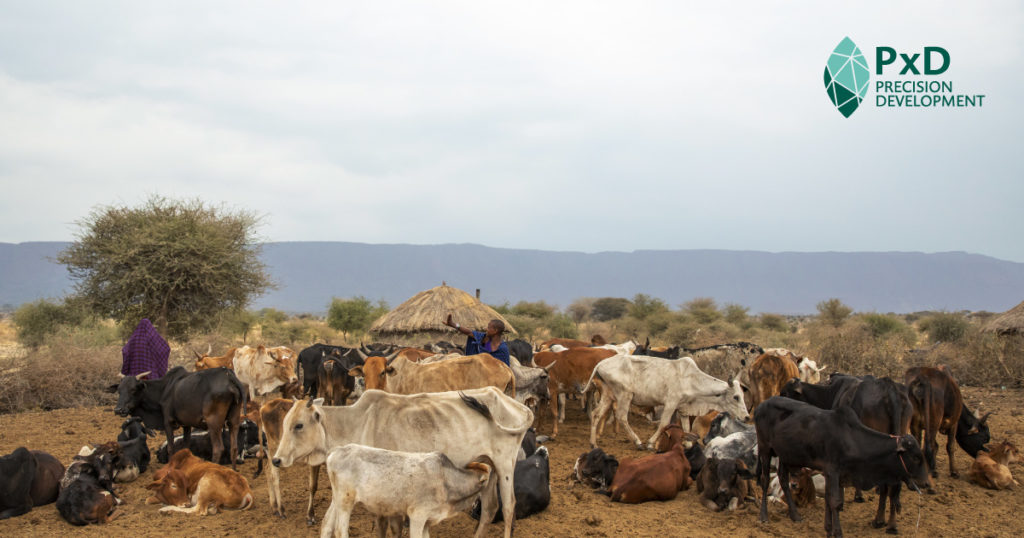
In many smallholder households, labor relating to the tending of livestock – particularly dairy animal husbandry and dairy production – is derived disproportionately from women. This culturally entrenched division of labor has direct implications for PxD as we expand into supporting dairy farming activities and seek to target our digital advisory services appropriately.
There is a plethora of evidence – much of it detailed in the excellent book, Invisible Women, by Caroline Criado Pérez – of service providers who failed to understand women’s specific needs and preferences and thus designed inferior products. Providers of digital advisory services are no exception to this disappointing phenomenon.
As PxD prepares to roll out a dairy advisory initiative in Kenya, we considered it a top priority to conduct a gender survey to better understand the roles played by each household member with a focus on tasks performed, decision-making, and financial agency. The results of this survey will be used to inform the dairy content we are developing as part of an upcoming randomized controlled trial (RCT) we are implementing in partnership with several dairy cooperatives across different regions in Kenya. We will use the results of the survey to inform the type of content we write, as well as how and to whom we deliver it.
As detailed in a previous blog post about the survey, the PxD Kenya team used a novel and rich dataset to inform survey design. In addition to gaining insights into the roles played by different members of the household, we also sought to better understand the technical and analytical abilities of each respondent, as well as perceived technical knowledge for each household member. Finally, we used methods from behavioral economics to empirically evaluate trust within the household.
Survey Structure
We started with a total sample of 600 households randomly selected from two dairy cooperatives, in the Rift Valley and Eastern regions. The sample was stratified by geography, milk sales to the dairy, and deductions for purchases from the dairy-affiliated agrovet (in which farmers are able to purchase animal medicines and farming inputs using income from milk).
We called 464 unique respondents, of whom 357 answered at least one call. Respondents who lived with or made decisions with their spouses were asked to provide contact information. Single respondents – many of whom were widows or widowers – were encouraged to complete the survey, but were not asked a series of subjective questions about the degree to which they made decisions or discussed activities with their spouses. Single respondents were also not asked to participate in the public goods game. In total, 114 spousal pairs completed the full survey. These spouses, and their respective households, will be the focus of this post. The demographics of the survey respondents and their households are shown in the table below.
Intra-household dairy roles. At the start of the survey, each respondent was asked to list the members of the household above the age of five, and state their age, gender, and education. The survey enumerators used tablets to record responses that allowed them to capture this information to be used later in the survey. Respondents were then asked to select from this list to indicate which member(s) of the household:
- Practiced crop farming, grazing, fetching water, wage employment [Respondents were specifically asked if they held “a job outside the home.”], schoolwork, childcare, and/or leisure in any given week. Respondents were also asked to indicate the number of hours each selected household member spent on each task in a typical day.
- Practiced various dairy tasks, selected from a list of tasks generated by our Staff Dairy Livestock Expert. For each task selected, respondents were asked to indicate which household member took primary responsibility, and how many minutes this individual typically spent on that task per day. This is the only household roster question for which the respondent was asked to select a single respondent rather than having the option to select multiple members.
- Were knowledgeable about nutrition, artificial insemination, hygiene, disease, and feed and fodder. The respondent was also asked to rank the selected household members in terms of their knowledge on that particular topic.
- Had taken various financial actions, including purchased a personal asset, purchased a productive asset, sold crops on behalf of the household, received payment for crops on behalf of the household, received payment for milk production, and made decisions about spending dairy income.
Analytical ability and dairy knowledge. Respondents were asked to answer a series of scenario-based analytical questions as well as questions to assess technical dairy knowledge on a broad range of topics. We then calculated the percentage of analytical and technical questions the respondent answered correctly.
Subjective assessment of financial agency and cooperation. Respondents were also asked to provide information on their personal knowledge and feelings of financial agency. To assess financial agency, respondents were asked to indicate using a Likert scale the degree to which they discussed finances with their spouse, trusted their spouse’s financial decisions, talked with their spouses about agricultural work, and talked with their spouse about their day generally.
Intra-household cooperation – the public goods game. Finally, all respondents who completed the survey were awarded 100 Ksh (approximately $1) in airtime, and – if their corresponding spouse had also completed the survey – they were invited to increase their earnings by contributing some portion of their earnings into a common account with their spouse. Since the amount contributed to this common account was doubled and then split evenly, the respondent’s contribution could be interpreted as an empirical measurement of cooperation with their spouse.
Information asymmetry. For the 115 households in which we collected information from both spouses, we were able to calculate the degree of coherence in their responses in terms of the intra-household (inter-spousal) correlation coefficient.
General Time Use & Dairy Tasks
Male and female respondents broadly agreed on the division of labor within the household by gender of household members. We focus our description of intra-household gender-specific roles on the share of time spent by males and females within the household and checked whether men and women respondents generally agree on this proportion. This is presented in Figure 1 below, which organizes respondents’ perceptions by the proportion of hours household members of different genders spend on pre-specified activities within the household (p-values reflect tests of the null that there is no difference in responses across spouses). While male and female respondents differed in their reports of the time spent by gender of the household member, these differences were not significant for any time-use category other than crop farming. In this instance, the difference in perceived hours on task from the perspective of male and female respondents was statistically significant at the 5% level (as demarcated by the p-values next to each bar). In general, respondents of both genders reported that crop farming, grazing, school, and leisure were split nearly evenly by gender. Female household members, however, were reported to spend more time fetching water and engaging in childcare relative to male household members, and male household members were more likely to have a job outside the home.
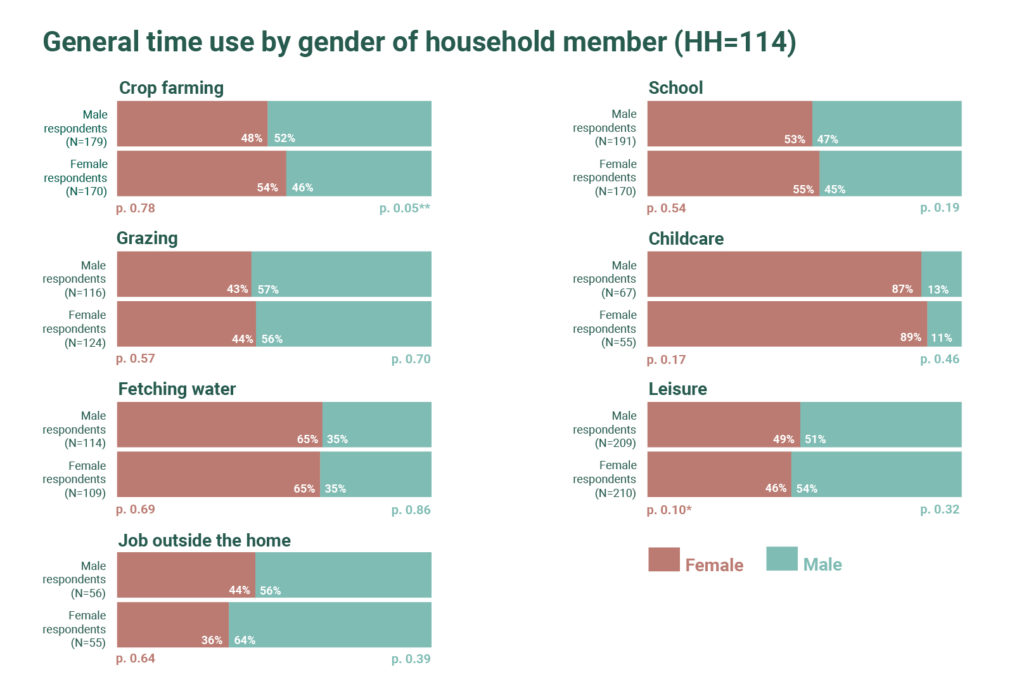
There was an overall alignment between male and female respondents on the reported activities of different age groups (Figure 2). The overwhelming majority of those in school were aged 5-20, while those aged 26-50 performed the bulk of income-generating labor, including crop farming, tending to grazing animals, and jobs outside the home, as well as tasks culturally associated with “women’s work” (fetching water and childcare). Leisure was fairly equally distributed across age groups.
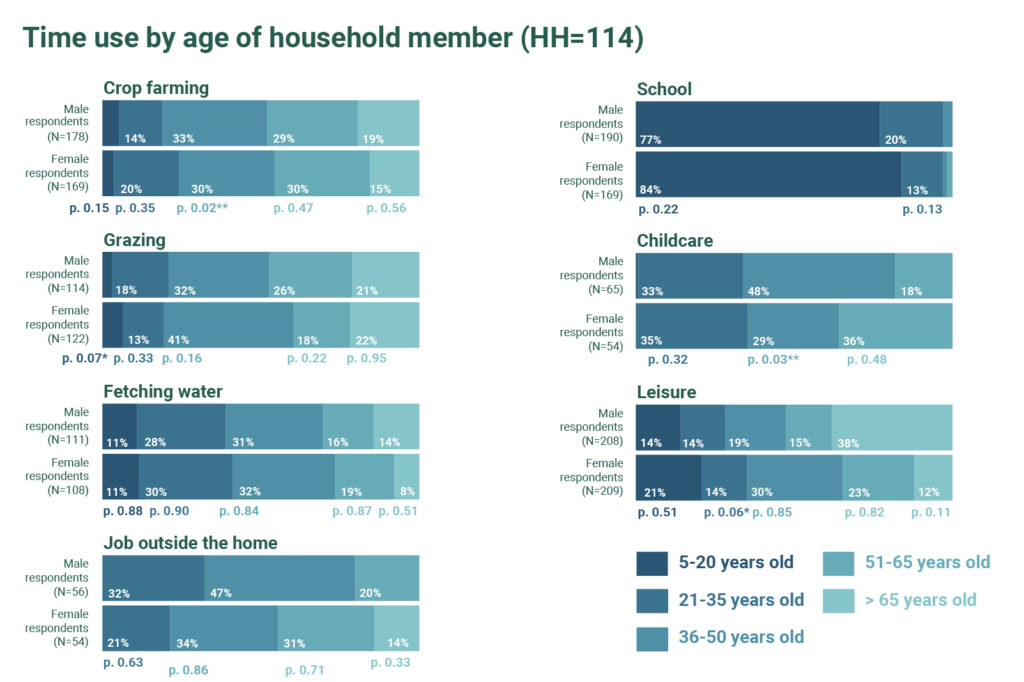
Of the 20 dairy tasks that each respondent was able to select from, nine were selected by respondents in our sample: cleaning the milking equipment, giving the cows water, feeding the cows, milking the cows, feeding the calves, transporting and selling milk, cleaning the housing unit, sourcing and threshing fodder, and sourcing feed and fodder. Figures 3 and 4 below applies the same analysis to these tasks as applied above to the responses on household time use: that is, Figure 3 analyzes the differences in male versus female respondents’ perceptions of household members’ dairy time-use by the gender of the household member, and Figure 4 analyzes this in terms of household member age group.
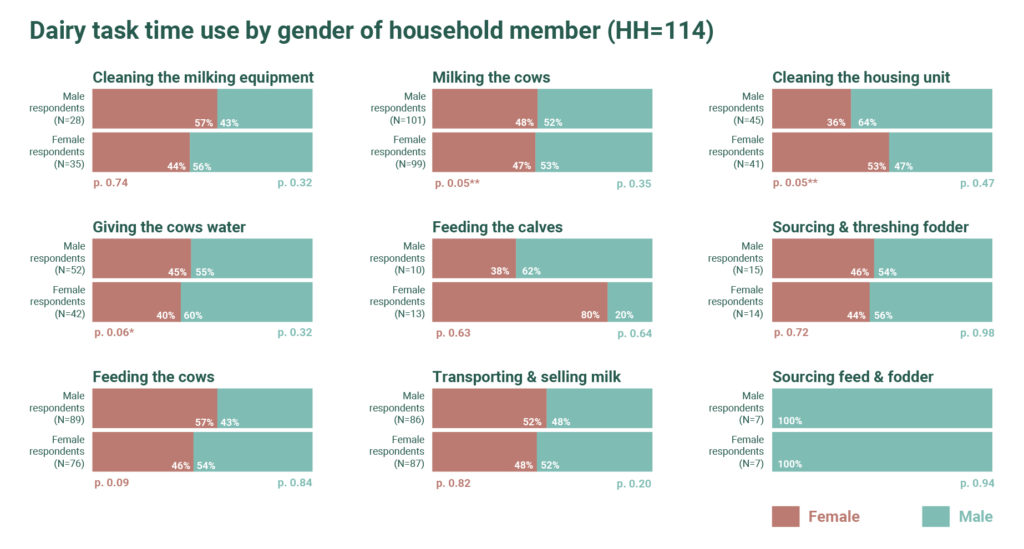
For most tasks, labor appears to be split fairly evenly by gender. A possible exception to this rule is feeding of calves, which female respondents assert is performed more by women than by men at a ratio of 4:1; men disagree on this, however, which is statistically significant at the 5% level, though the relatively low sample size makes it hard to put too much stock in this comparison. Further analysis could examine whether there is a difference based on a household’s production system. For example, in zero-grazing (or semi-zero-grazing) households, domestic tasks may account for a larger share of household labor, in turn skewing labor allocation toward the purview of women.
In addition to splitting labor by gender, dairy-related labor also appears to be distributed relatively evenly across age groups. The exceptions to this rule are “feeding the calves” and “cleaning the housing unit,” which according to female respondents – but not male respondents – is overwhelmingly performed by younger populations. Though difficult to say conclusively, a possible explanation for this difference in reporting is that female respondents may be more aware of how labor is divided on these tasks, which tend to be domestic in nature.
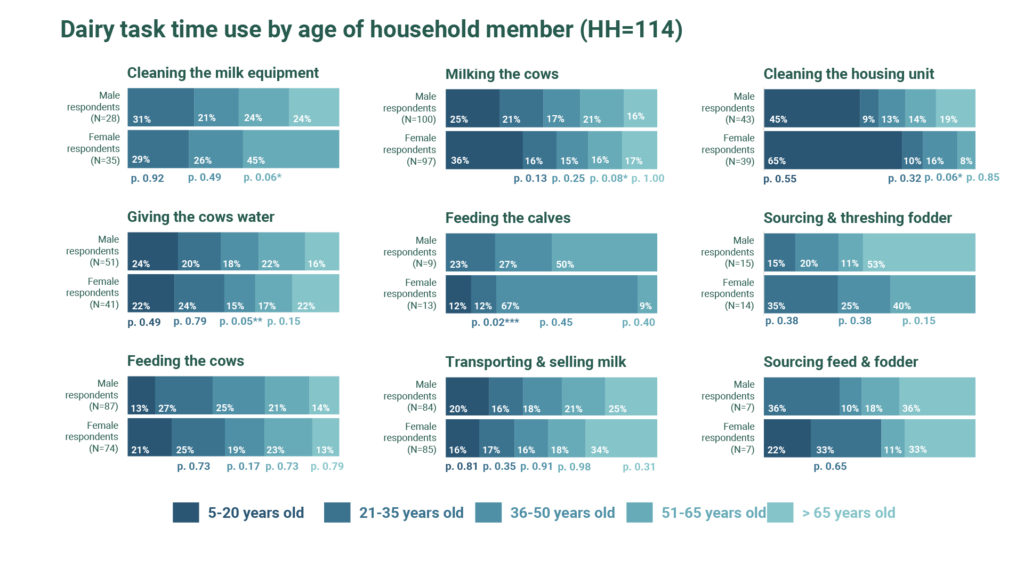
While on average there seems to be a great deal of agreement between spouses in our sample, this does not preclude the possibility of variation in the degree of agreement across households. Figure 5 below displays a measure of within household agreement by calculating the correlation coefficient in the vector of responses provided by women and men respondents in the same household. If, for example, on average, most husband and wife pairs agree on the time spent within the household on childcare, the correlation coefficient will be closer to 1. If they systematically disagree, the correlation coefficient will approach -1. If the correlation coefficient is close to zero, there is no clear agreement between husbands and wives within the same household on how tasks are distributed among household members. In our survey, there was a high degree of correlation between spousal responses for general time-use categories (i.e., crop farming, childcare, leisure, etc.).

Knowledge
Prior to measuring actual analytical skills and technical knowledge, we asked respondents to subjectively indicate which household members possessed knowledge in five categories: nutrition, artificial insemination, hygiene, disease, and feed. We then calculated the total percentage of individuals within a household perceived to have knowledge on a topic by gender (Figure 6) and age group (Figure 7).
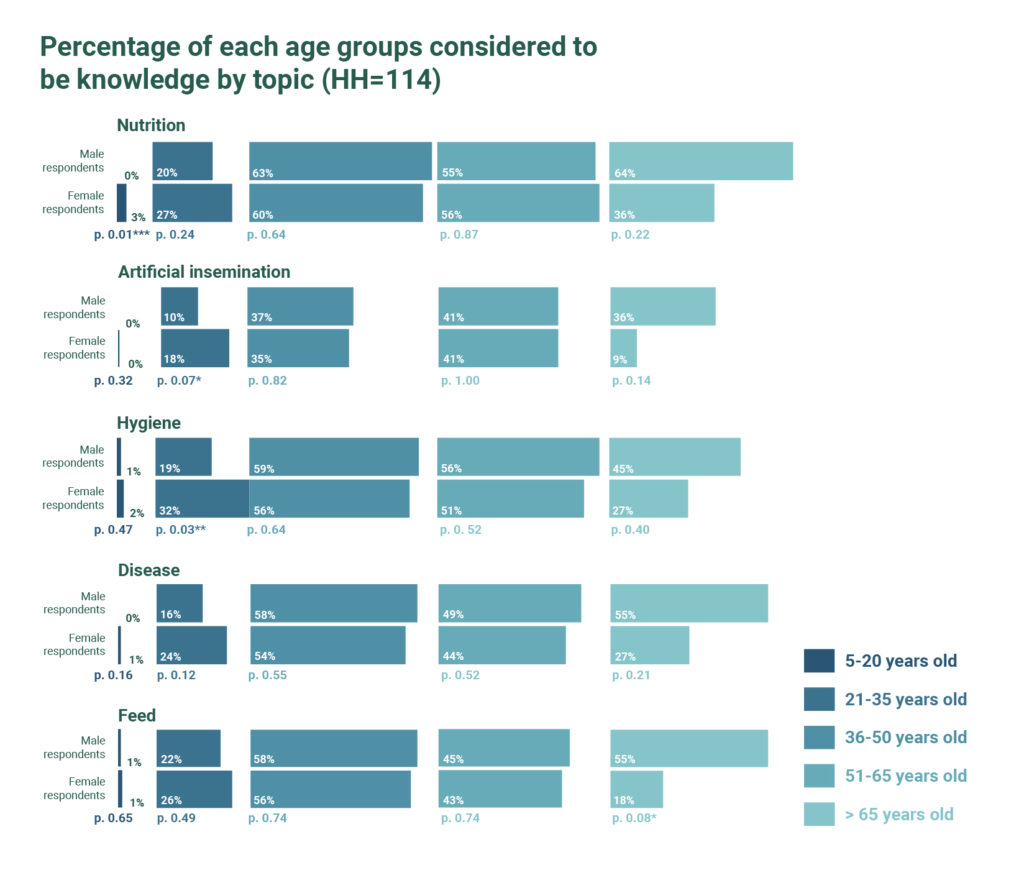

Across all categories, both male and female respondents perceived male household members to be more knowledgeable; there was broad intra-household agreement on knowledge perceptions as well (see Figure 8). Interestingly, male household members were judged to be especially knowledgeable in categories such as disease and artificial insemination; this was particularly true in the eyes of male respondents, who judged male household members to be at least twice as knowledgeable as women about these subjects. One hypothesis for this is that these subjects may carry a connotation of expertise due to their affiliation with actual professionals (i.e. veterinarians). By contrast, the perceived knowledge gap was a lot lower for other categories, such as nutrition and hygiene.
In fact, when tested, male respondents did perform significantly better than female respondents in terms of technical knowledge, with a mean score seven percentage points higher. That said, male respondents performed no better than female respondents on a test that used scenario-based questions to measure analytical thinking.
That said, two caveats must be considered in drawing conclusions from these results (shown in Figure 9): First, these results measure respondent knowledge rather than directly evaluating the knowledge of all household members. Second, the tests were brief and covered a broad array of subjects, making it impossible to evaluate whether the respondent may have deep knowledge on a particular topic. Both of these gaps suggest promising areas for future research in order to better understand the degree to which perceptions of knowledge match reality, rather than merely reflecting cultural biases; in reality, the answer may well be both, though additional empirical analysis is needed to make this claim.
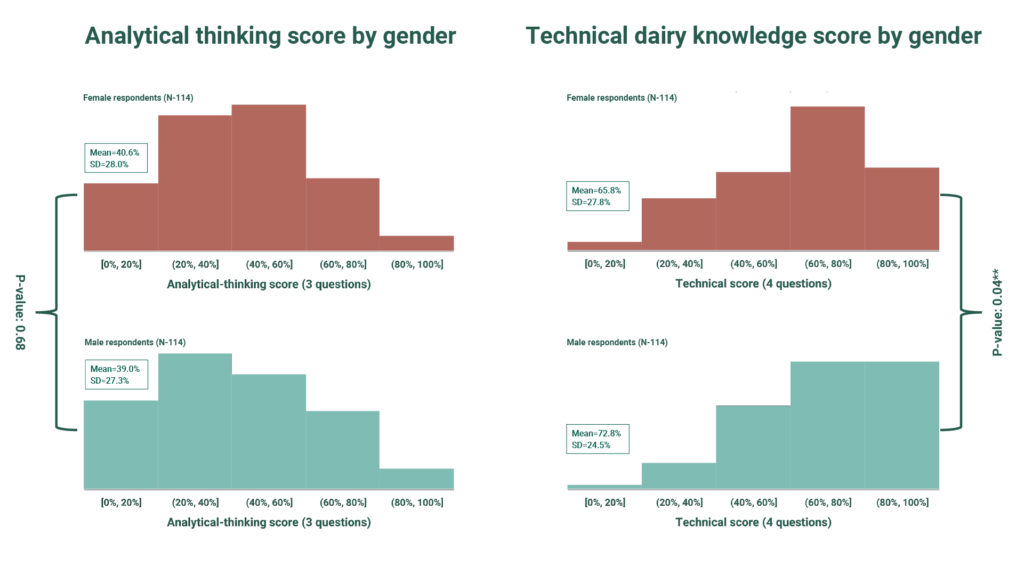
Financial Agency, Intra-Household Decision-Making, and Trust
Respondents were asked a series of questions regarding their perceptions about who controlled money within the household: who in the household purchased productive assets, purchased personal assets, purchased inputs, sold household crops, received payments for crops, received payments for milk money, made decisions about spending milk money, and owned a financial account. Figures 10 and 11, respectively, analyze these results by gender and age of the household members.
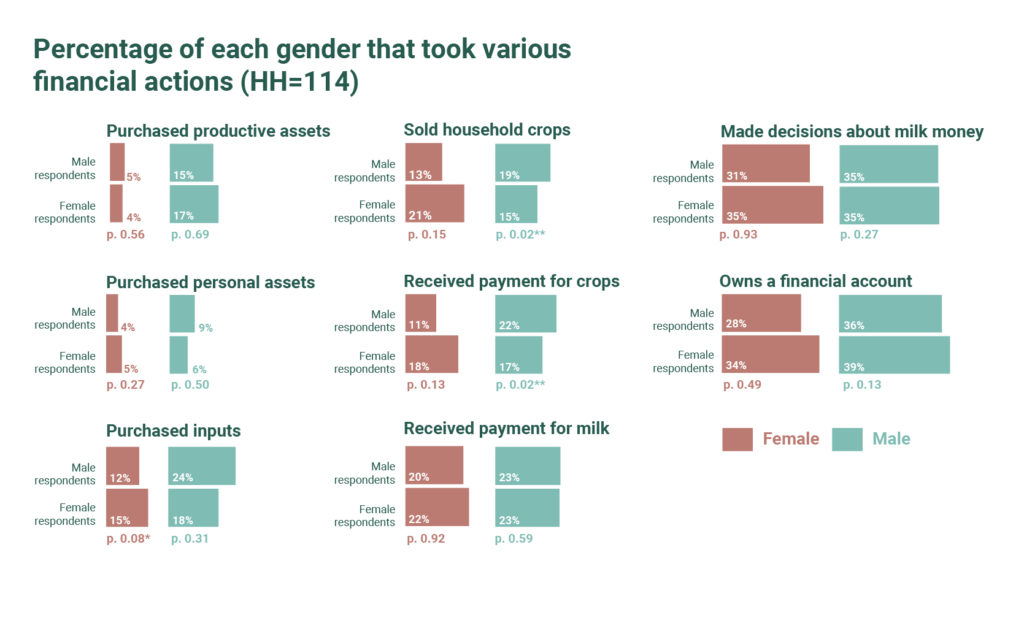
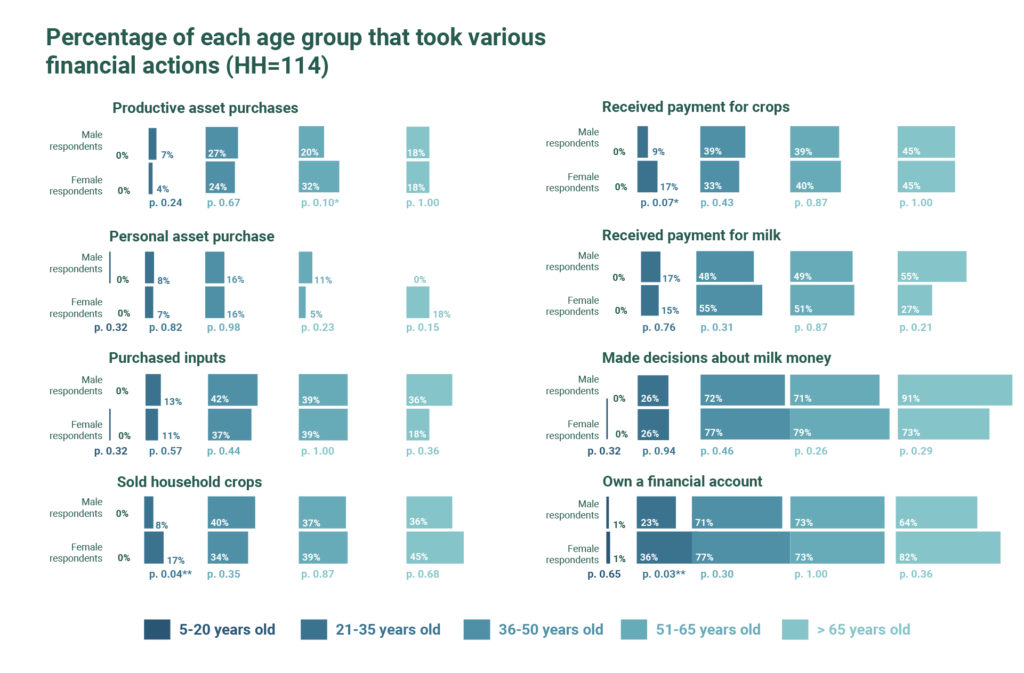
Very few household members were reported to have purchased personal assets; more – overwhelmingly men – purchased productive assets, according to both male and female respondents. Male and female respondents also agreed that payment for milk money and decisions about milk money were generally split evenly within the household. Both male and female respondents also reported that household members of both genders owned financial accounts (though men did so to a slightly higher degree).
There was less agreement by respondent gender about crop farming. Male respondents reported that male household members played a larger role in selling crops, whereas female respondents reported the opposite. This same pattern was true regarding respondent perceptions of who received payment for crops. In both cases, the difference in the perception of different genders was statistically significant at the 5% level. Additionally, while respondents of both genders agreed that more male household members purchase inputs than female household members, male respondents reported the ratio to be 2:1, while female respondents reported this difference to be marginal; this disagreement was weakly statistically significant (at the 10% level). Within households, there was also comparatively more disagreement on the measures related to crop farming and associated income, as shown in Figure 12.

There are several potential explanations for the disagreement on this measure. One potential reason is there may be an internal lack of clarity within the household about who performed which category of tasks. This does not necessarily mean that individual tasks do not have a “clear” owner; alternatively, the divisions we at PxD made for the purposes of this survey may not correspond to household constructs around the division of finances. This suggests a possible area for future research: an open-ended survey consisting of structured interviews on this topic may yield interesting insights regarding financial accountability and power within the household.
Moreover, the disagreement may reflect the fact that some tasks may be performed jointly (or in an alternating fashion) with other household members; this possibility need not be mutually exclusive with alternative divisions of labor within the household. The results in Figure 13 suggest this possibility. When asked who makes financial decisions about the farm, the majority of women (62%) and men (82%) said they made this decision together with their spouse; an additional 25% of women said they did so jointly with the household head. Even who the “primary” decision-maker was could be muddled, with 72% of women and 50% of men claiming to occupy this role jointly with either a spouse or household head.
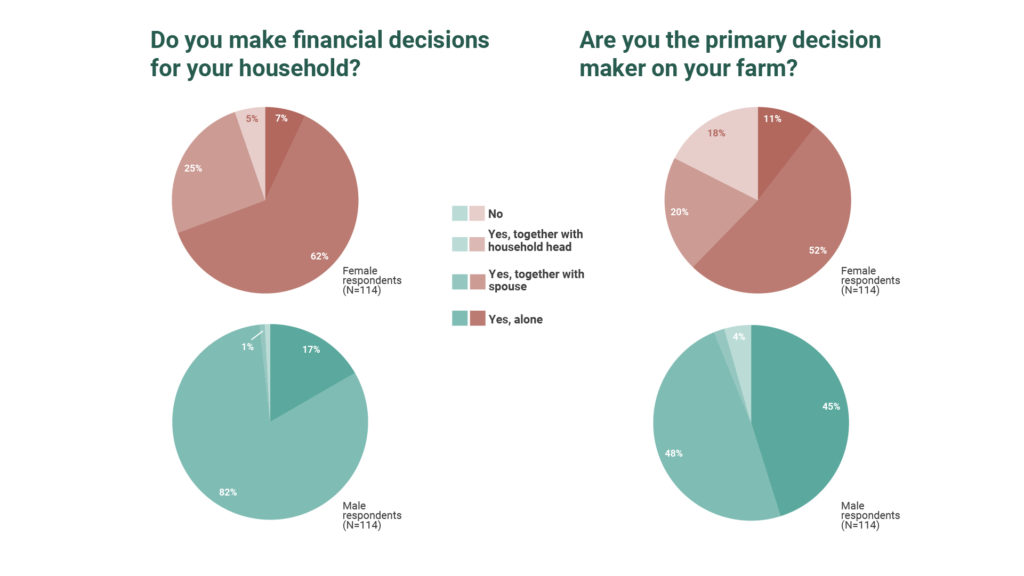
These results are ambiguous regarding whether each decision is made jointly or whether men and women have different spheres of influence within the household (and financial discretion within those spheres). However, the Likert scale questions, in which respondents were asked to agree or disagree with a number of statements about intra-household decision-making suggest that many decisions are made jointly – or at least with a substantial discussion between household members. (Figure 14)
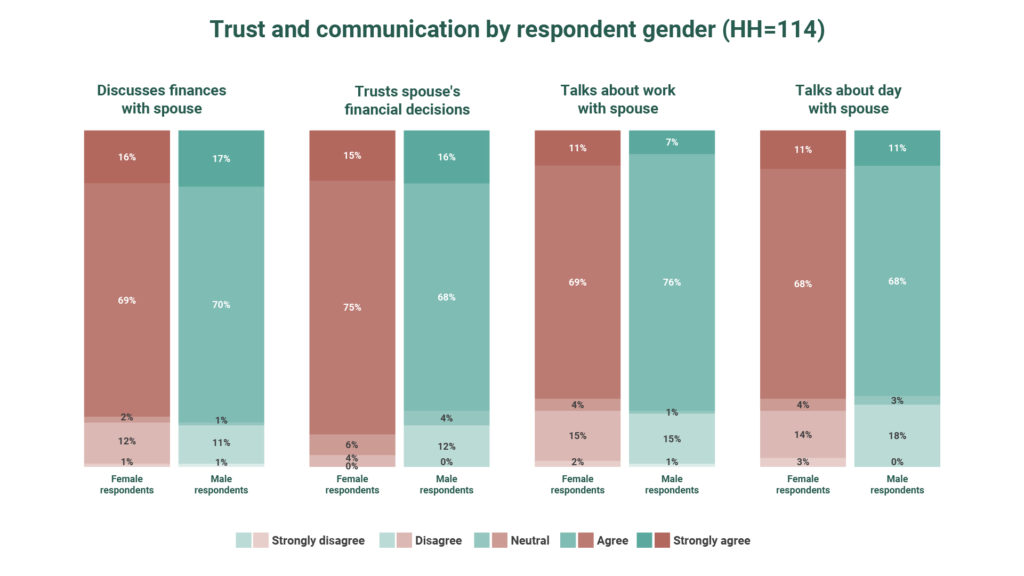
Eighty-five percent of female respondents and 87% of male respondents reported that they discussed finances with their spouse; moreover, 90% of female respondents and 84% of male respondents reported that they trusted their spouse’s financial decisions.
In order to empirically test these subjective responses, we also asked respondents to participate in a “public goods game,” in which they could choose to augment a portion of the financial incentive they earned for completing the survey (100 Ksh, or about 1USD) to a common account. Contributing a greater amount theoretically indicates a greater degree of cooperation with one’s spouse since the amount in the common account was split evenly between spouses after both completed the exercise, regardless of how much each spouse contributed individually. The results of this game suggest a moderate amount of trust, with contributions for both women and men clustering around the midpoint of the range between zero and the total possible contribution. Figure 15 displays the distribution of these respondents’ contributions. While male respondents contributed more on average (statistically significant at the 5% level), the plurality of respondents of both gender contributed a medium amount (i.e., 40-80 Ksh)
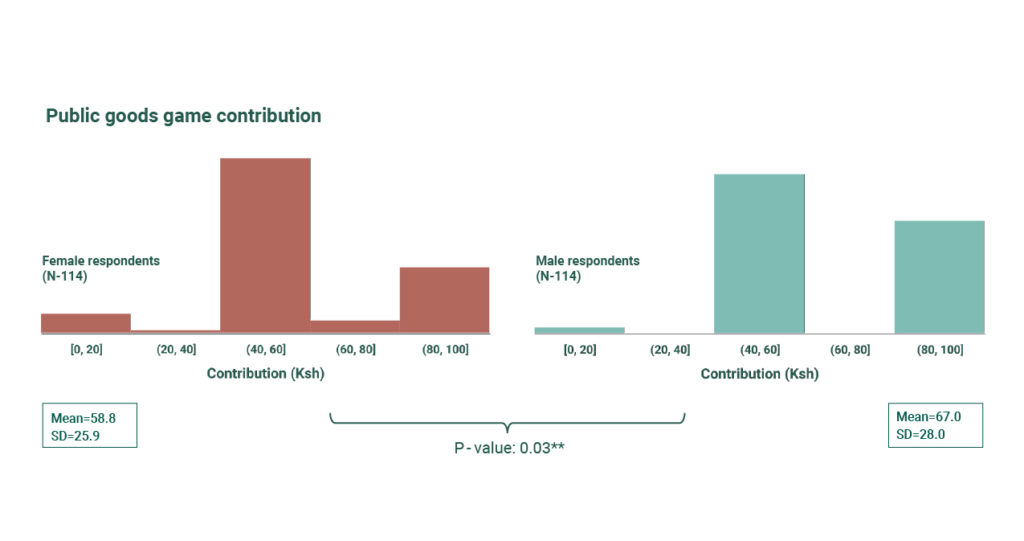
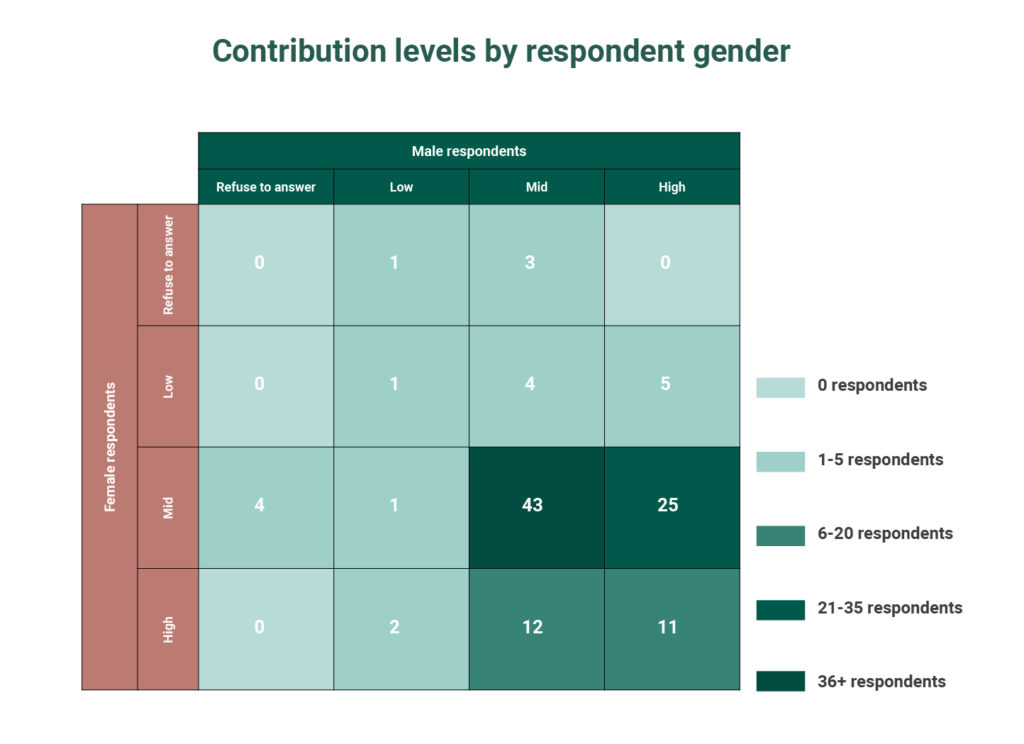
One way to empirically evaluate whether the public goods game in practice aligns with subjective cooperation in the household is to directly compare these results. First, we regressed the correlation coefficient between the spouse’s individual Likert responses – that is, the degree to which husband and wife agreed about their level of trust or communication – on the various contribution categories (limited the covariates to the bottom quadrant of Figure 16, to make sure each category reflects a sufficient sample of people to draw meaningful conclusions). The results of this regression are shown in Table 2. There was not a high correlation between these metrics, with none of the contribution categories predicting agreement between the spouses regarding the degree of cooperation.
The next stage of analysis was to compare directly the responses to the Likert scale questions on intra-household communication and trust to the public goods game contributions. To do so, we first split the sample by respondent gender and then ran ordered logit regressions separately for each sample (Table 3). In these regressions, a positive coefficient signifies that a member of a household in that specific contribution category is more likely to “strongly agree” with the statement. To make this concrete, the variable “female mid, male high” in the female sample is equal to one for a member of that population who contributed a medium amount (40-80 Ksh) and whose husband contributed a high amount (80-100 Ksh), and is equal to zero otherwise. A positive coefficient on this variable means that a respondent in this category is more likely to “strongly agree” with an affirmative statement on the Likert response; e.g. for the first regression in the table, she is more likely to say she often discusses finances with her spouse. While all the coefficients for the regressions on the male sample and about half of the coefficient for the regressions on the female sample are positive, none of the results in either sample are statistically significant.
Since the public goods game contributions do not align with subjective measures of intrahousehold cooperation, it is unclear whether respondents are less trusting in practice than they aspirationally report to be on the subjective questions, or whether the public goods game does not accurately measure intrahousehold trust. The answer may be a combination of the two or may vary by Likert category. This suggests an area for future research.
Next Steps
This information is valuable for informing the design and operation of a dairy service that empowers rather than further marginalizes female farmers. It bears mentioning that we will continue to monitor engagement by gender to validate the insights of this survey on an ongoing basis and to make sure that we continue to reach women farmers.
That said, there are a few points we can take away from this dataset –
and we can use it to identify areas for additional research:
- In general, women and men reported that they split labor related to crop farming and grazing, and both females and males reported going to school and pursuing leisure activities. Unsurprisingly, women reported spending more time fetching water and engaging in childcare relative to men, and men were more likely to have a job outside the home. Perhaps more surprisingly, most dairy tasks were split relatively evenly by gender. Further research could investigate the ways different production systems influence household division of labor: for example, since women generally take charge of more domestic tasks, in zero-grazing households is dairy-related labor more commonly performed by women?
- Both men and women perceived men to be more knowledgeable on all topics asked about (nutrition, hygiene, artificial insemination, and feed). One positive of digital advisory compared to traditional in-person systems is that both women and men are able to read the advice on their own, and thus may be less subjected to the influence (and doubts) of peers and other household members. However, this knowledge gap may have implications for marketing: if women are systematically viewed as less knowledgeable, men may find a service that aims to disrupt that balance in the household to be threatening. Additionally, the perceived knowledge gap may pose a barrier to adoption of recommendations by women if proposed without male buy-in and perceived to not know what they are talking about.
- The allocation of financial power in the household was far from clear-cut. A similar proportion of both genders received payment for and made decisions regarding milk money, and respondents of each gender disagreed as a group about which gender sold and received payment for crops. Additionally, the majority of respondents of both genders reported making financial decisions and being a “primary decision-maker” – either individually or jointly with a spouse or household head. Finally, both male and female respondents reported discussing finances with their spouse and trusting their spouse’s financial decisions. While this has positive implications for adoption of advice by both genders, it also suggests that many decisions are made jointly and buy-in from both spouses is necessary for implementation.
- The responses of respondents of both genders to the Likert scale questions suggest a high level of intra-household communication, trust, and cooperation, at least in the subjective opinions of respondents. Similarly, the vast majority of respondents of both genders contributed at least a medium amount (40 out of a possible 100 Ksh) to the common account in the public goods game. This has positive implications for adopting recommendations, which in many cases will require collective household buy-in. That said, there remains opportunity for a more granular understanding of intra-household cooperation. For example, how does it differ in households with more defined household and/or farming roles, or in households where one spouse is clearly knowledgeable? (While this dataset contains questions to this effect, the sample size is too small to draw meaningful conclusions about precise subsets of respondents.) Outside of this data, what impact do production systems (i.e. zero-grazing) and use of particular technologies (e.g. machinery such as chaff cutters or other equipment, such as durable water tanks) have on the level of intra-household cooperation?
While the effort to better understand our service users is ongoing and our efforts to improve content and delivery are constantly evolving, this data collection yielded meaningful insights and constituted a significant step towards inclusive product and service design that can be put to use in PxD’s Kenyan dairy service – and more broadly in programming across the region.
Vaishnavi Surendra, Post-Doctoral Researcher, and Revati Vaidya, Process and Product Innovation Associate, mark the International Day of Rural Women
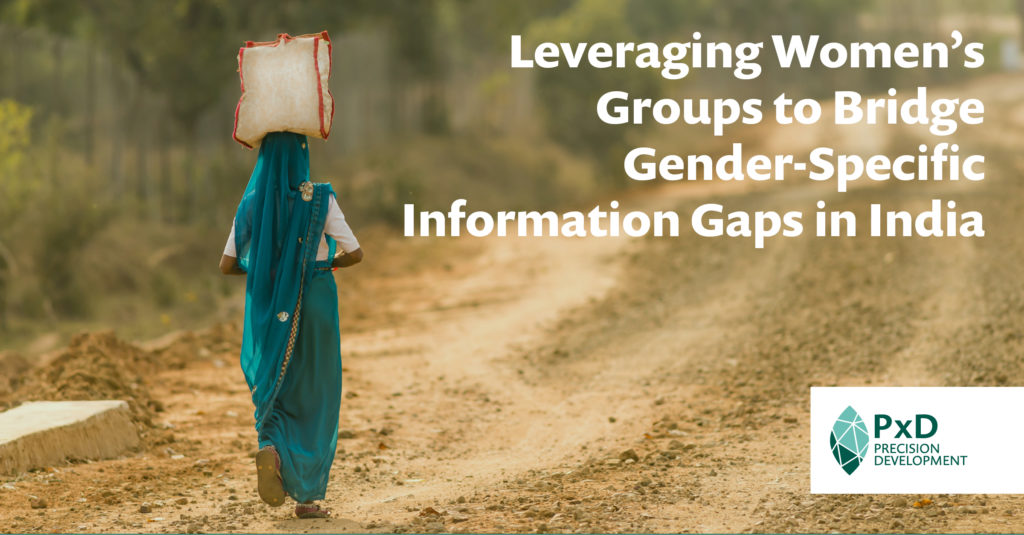
At PxD, we aim to generate research and design products and services that bridge information gaps for people living in poverty. On this International Day of Rural Women, we reflect on our efforts to understand the unique challenges confronting rural women, and how PxD’s digital services can complement the work of women’s groups to empower and serve the needs of rural women.
Gendered constraints and PxD’s existing services
How does one design products and services for women that meet their unique information needs in a scalable manner?
Cultural norms and socio-economic structures often restrict women’s autonomy, mobility, and economic opportunities. When women seek financial service, healthcare, entitlements, or other livelihood-enhancing products and services, they are likely to confront a number of constraints. In addition to the barriers associated with lower levels of literacy, digital literacy, education, autonomy, or mobility that inhibit demand and restrict women’s opportunities, many rural contexts offer a limited or nonexistent supply of products and services designed to meet women’s needs.
Unsurprisingly, women’s access to and engagement with our mobile phone-based services lags that of their male peers. We estimate that 23% of our 4.4 million current users are women. To make our existing services more accessible and relevant to women, we are iterating both the content of our advisory services and ways in which users can access them. For instance, in Odisha, we recently conducted a gender-scoping survey to more effectively understand how access, time use, and division of labor vary by gender. We found that women farmer-users, inter alia, are more likely to be engaged in livestock rearing, the cultivation of horticultural crops, and the tending of kitchen gardens. As a consequence, we now provide advisory tailored to these activities to increase women’s engagement with our services.
A more complex challenge is that women often don’t have access to mobile phones. PxD’s services generally rely on users having direct access to a mobile phone to scale the dissemination of information. Gender gaps in mobile handset ownership, and cultural norms that constrain women’s access to and use of mobile phones, complicate our ability to meet the needs of women using digital information dispensed via mobile phones. In India, for example, only 38% of women own mobile phones, compared to 71% of men (Barboni et al., 2018). This gap is likely to be even larger in rural areas. We are currently exploring whether nudging male users registered on our Ama Krushi service in Odisha to switch on their mobile phone’s speaker when they receive advisory calls to facilitate greater women’s engagement. An additional line of inquiry – about which we are particularly excited – is to interact with women users via women’s groups rather than attempting to serve individual women directly.
Women’s groups in India
In many contexts, women’s groups are a popular approach to empowering women and addressing gender gaps. While the specific structure, membership, and goals of these groups vary across contexts, they generally share the following features: (i) voluntary membership; (ii) members’ contribution of time, money, or other assets; and (iii) regular face-to-face interaction among members (Biscaye et al., 2014; Dìaz-Martin et al., 2021). Women’s groups typically aim to provide members with knowledge, training, access to financial products, or access to agricultural input and output markets to facilitate improved livelihoods, financial inclusion, better literacy, and numeracy. In all instances, greater access to information has the potential to complement and enrich these offerings.
In India in particular, policymakers and practitioners increasingly view women’s groups as effective platforms capable of scaling the delivery of a range of interventions at a relatively low cost per person (Gugerty et al., 2019). Moreover, women’s groups are perceived to effectively leverage social interactions among group members to improve the impact of each intervention. In India, women come together in women’s cooperatives, farmer producer organizations, entrepreneurial marketing organizations, women’s labor collectives, microfinance groups, and most commonly in self-help groups (SHGs). Currently, there are over 7.2 million SHGs registered with the NRLM, the largest such program in the country. Areas in which women’s groups are active in expanding access and use of services and resources include access to financial services (e.g., the National Rural Livelihoods Mission (NRLM)), community health and access (e.g., the Swayam Shikshan Prayog program), and livelihood training (e.g., the National Bank for Agricultural and Rural Development’s (NABARD) Microcredit Innovation program).
Existing evidence indicates that women’s groups have been successful in facilitating greater financial inclusion (for instance, in Hoffmann et al., 2021; Banerjee et al., 2015), and some evidence suggests that their activities have had moderate effects on small business investments and profits (such as in Banerjee et al., 2015). Certain women’s groups have also successfully improved women’s political (Prillaman, 2021), economic and social empowerment (Brody et al., 2015) while others have demonstrated no such impacts (for instance, in Joshi, Palaniswamy, and Rao, 2015; Hoffmann et al., 2021). Most relevant to our use-case, in a study of 1,000 women across five states in India, Raghunathan et al. (2019) find that the provision of agricultural extension services through self-help groups improved women’s access to information and their participation in some agricultural decision-making, but that this had limited impact on agricultural practices or outcomes.1
We are confident that women’s groups in India can be effectively leveraged in ways that enable more women to access mobile phones within their groups, and engage with mobile-based services more meaningfully, than what might be possible utilizing strategies targeting individual women users. Moreover, we believe that such groups might help women access relevant information in a friendly and supportive environment since they tend to be spaces that foster and rely on camaraderie and trust. A demonstrated strength of women’s groups in India (SHGs and otherwise) is their ability to scale and bring the benefits of scale to members at the grassroots level. This is demonstrated, for example, by efforts to federate SHGs by consolidating them across villages, blocks2, and districts under the NRLM; and through the structures of SEWA, a national federation of ‘organizations of women working in the informal economy’.
Moving forward
We see women’s groups as an opportunity for PxD to reach more women with information that has the potential to improve their lives and empower them as community leaders. Examples of initiatives we are exploring are:
- Using our existing IVR-service to connect to one phone in each group during group meetings to provide technical assistance relating to agricultural practices; to facilitate training for improved access to and meaningful use of digital services (e.g., digital finance); and/or deliver nudges and encouragement to assist women with planning and management of things like individual or household finance, educational investment, or entrepreneurship. In addition to encouraging group members to share the phone, and therefore increase the reach of PxD’s digital information delivery, we also anticipate that disseminating information in groups may facilitate “social learning” among group members; for example, early adopters of PxD’s recommended agricultural practices may encourage their peers to adopt similar approaches by demonstrating positive results.
- We also see women’s groups as being effective vehicles for facilitating the aggregation of information from markets or communities through crowdsourcing, and the potential to set up a directory or repository of agglomerated information that can be accessed across user-groups. For instance, in contexts where women have limited access to information on market conditions (such as input availability, the price of inputs and of outputs, what services are available and useful, job opportunities close to their homes, etc.), a PxD service may be effective in facilitating the sharing of leads or information within and between groups during meetings. By implication, a service or platform like this is more likely to have information relevant to the needs and interests of women.
- Finally, we also see being able to complement the existing goals of many such groups and collectives by affirming women as community leaders. Part of this may entail delivering specific digital training to women’s groups or helping women become resource persons for their local communities. This might be useful in areas such as pest identification and management, or for information about community natural resources and their management. The group structure may also assist more women to access relevant information and training than if it was limited only to women with access to phones. The perception of additional leadership credentials, or the facilitation of greater leadership agency, may accrue as a consequence of women acting as “agents” who can connect with PxD’s services and deliver information to community members who lack mobile phone access.
We are excited by the potential of these channels for improving women’s economic outcomes, increasing their bargaining power, and affirming women leaders — and facilitating leadership roles — within their communities. We are actively looking for partner organizations to work with us to iterate our ideas and bring them to fruition. We look forward to keeping you posted as we proceed!
References:
- Banerjee, Abhijit, Esther Duflo, Rachel Glennerster, and Cynthia Kinnan. 2015. “The Miracle of Microfinance? Evidence from a Randomized Evaluation.” American Economic Journal: Applied Economics. 7(1): 22–53.
- Barboni, Giorgia, Erica Field, Rohini Pande, Natalia Rigol, Simone Schaner, and Charity Troyer Moore. 2018. “A Tough Call: Understanding barriers to and impacts of women’s mobile phone adoption in India.” Evidence for Policy Design: Harvard Kennedy School.
- Biscaye, Pierre, Zoe True, Christopher Clark, Katie Panhorst Harris, Leigh Anderson, and Mary Kay Gugerty. 2014. “Self-Help Groups in Development: A Review of Evidence from South Asia AndSub-Saharan Africa.” EPAR Brief 283.
- Brody, Carinne M, Thomas De Hoop, Martina Vojtkova, Martina, Ruby Warnock, Megan Dunbar, Padmini Murthy, and Shari Dworkin. 2015. “Economic Self-Help Group Programs for Improving Women’s Empowerment: A Systematic Review.” Campbell Systematic Reviews 19.
- Dìaz-Martin, Lucia, Akshara Gopalan, Eleonora Guarnieri, and Seema Jayachandran. 2021. “Greater than the Sum of the Parts? Evidence on Mechanisms Operating in Women’s Groups.” Working Paper.
- Gugerty, Mary Kay, Pierre Biscaye, and C Leigh Anderson. 2019. “Delivering development? Evidence on self-help groups as development intermediaries in South Asia and Africa.” Development Policy Review, 37(1): 129–151.
- Hoffmann, Vivian, Vijayendra Rao, Vaishnavi Surendra, and Upamanyu Datta. “Relief from Usury: Impact of a Self-Help Group Lending Program.” Journal of Development Economics, 148: 102567.
- Joshi, Shareen, Nethra Palaniswamy, and Vijayendra Rao. 2015. “Impact Evaluation Framework and Results: Odisha Rural Livelihoods Project.” The World Bank.
- Prillaman, Soledad Artiz. 2021. “Strength in Numbers: How Women’s Groups Close India’s Political Gender Gap.” American Journal of Political Science, forthcoming.
- Raghunathan, Kalyani, Samyuktha Kannan, and Agnes R. Quisumbing. 2019. “Can women’s self-help groups improve access to information, decision-making, and agricultural practices? The Indian case.” Agricultural Economics, 50: 567–580.
1 Diaz-Martin et al., 2021 provides a comprehensive overview of the evidence.
2 In India, a block is a subsidiary administrative unit below a district.
Sam Carter, Revati Vaidya, Simon Rubangakene, Georges Poquillon and Habtamu Yesiget recount how we improved our content and services by learning about our end-users response to messages recorded with men’s voices and women’s voices.
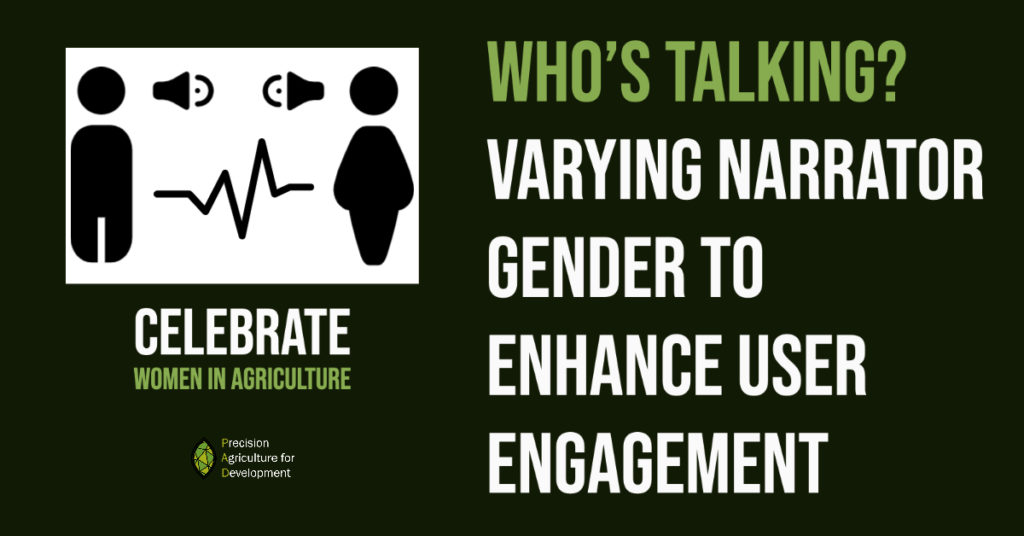
Do farmers act differently when they hear a woman’s voice giving them agricultural advice? How much does this matter in the nine different countries where we operate? These are questions we often ask ourselves since interactive Voice Response (IVR) and push calls are the bread and butter of our outreach to smallholder farmers.
Rigorous research is in our DNA, since PAD was born out of a study proving that mobile-phones can cheaply deliver actionable agricultural advice to farmers. We routinely test and evaluate different versions of our service to identify the best way to engage farmers with our services and, ultimately, turn our advice into action. We’ve tested the length of voice calls, the order in which menu options are presented, and use of urgent language in our messages among many others.
In Uganda, Ethiopia, and India, PAD has conducted A/B tests to understand whether the gender of the person narrating the advisory content has an impact on farmers’ pick-up and listening rates. In Uganda, we found that switching from a male to female narrator increased farmers’ engagement with PAD content, and as a result, we will use a female narrator for all new content developed for that program. In Ethiopia, on the other hand, we found that both pick-up and listening rates were higher when content was voiced by a male narrator than a female narrator. Meanwhile, in the Indian state of Gujarat, we found no statistically significant difference in engagement rates based on the gender of the narrator. Taken together, these results suggest the need for a nuanced, contextually-grounded approach to understanding the role that the narrator’s voice plays in determining farmers’ engagement with our service.
This blog post presents a summary of each experiment design and its results, and teases out the implications of these results in time and place:
Uganda
Simon Rubangakene, Project Associate and Georges Poquillon, Senior Research and Operations Manager
PAD’s service in Uganda
In Uganda PAD delivers digital training to smallholder farmers as part of an initiative run by Uganda Coffee Agronomy Training (UCAT) – a program implemented by the non-profit organizations Hanns R. Neumann Stiftung and TechnoServe – which delivers training to approximately 60,000 farmers in western Uganda via Farmer Field Schools. UCAT aims to train farmers to implement Good Agronomy Practices (GAPs) to increase yields and – by association – livelihoods.
PAD provides digital training to 4,000 UCAT farmers who are participating in a randomized evaluation in which farmers receive standalone and reinforcement training. The evaluation intends to understand the impact of varied approaches to agronomy training and/or extension services.
PAD’s digital advisory is pushed to farmers’ mobile phones in four different languages (English, Luganda, Runyankole and Rutooro). Standalone farmers who are not part of the UCAT program are also able to call in and record questions, which are answered by an agronomist within 48 hours. Standalone farmers and those attending training run by Hanns R. Neumann Stiftung receive IVR calls on a weekly basis, whereas farmers attending training run by TechnoServe receive advisory messages once a month.
How the A/B test varied the gender of the narrator, and why we decided to test this question
Prior to this A/B test, PAD’s advisory service in Uganda included content delivered by both male and female narrators. Due to the way in which language-use was distributed, few farmers receiving advisory from PAD were receiving advice voiced by a female narrator which made it difficult to identify listening patterns linked to voice. The Uganda team decided to implement an A/B test to better understand how farmers’ listening rates varied based on the voice of the narrator.
The study ran for eight weeks, from October 14, 2020 to December 9, 2020, a time coinciding with the runup to, and active period of the coffee harvest in Uganda. For this A/B test, we randomly assigned the 4,009 UCAT farmers receiving advisory from PAD to one of two groups. Group 1 (2,004 farmers) received content voiced by a narrator whose gender did not match their own. Group 2 (2,005 farmers) received content voiced by a narrator of the same gender. We stratified the sample to ensure that both groups were balanced in terms of language and the organization implementing the in-person training.
Results of this A/B test
Switching the message content from being voiced by a man to being voiced by a woman positively and sustainably increased the probability that female farmers picked up IVR calls, while there was no effect on the likelihood of a male farmer taking a call. With regard to the propensity to listen to most of the IVR call content, switching from a female to a male narrator reduced the listening rate of male farmers, while the opposite held true when switching from a male to a female narrator. However, the effect on the male completion rate was found to be lower over time. In the case of female farmers, switching from a male to a female narrator increased the likelihood that they listened to most of the message, with more long-lasting effects.
The findings suggest that both male and female UCAT farmers are more sensitive to messages voiced by a female narrator. However, the short-term nature of some effects may prevent such a change from generating long-run changes in farmers’ engagement. Moreover, only two narrators of each gender were involved in the recording, so we cannot rule out the possibility that we are capturing a “narrator” effect rather than a gender effect.
Implications for programming and future research
A direct consequence of the findings of this study is that the new UCAT content will be entirely voiced by female narrators. Farmer engagement following the introduction of this new content will be monitored to assess whether any change arises, leading to improved listening and completion rates.
Ethiopia
Habtamu Yesigat, Director of Programs, Ethiopia
PAD’s service in Ethiopia
PAD has collaborated with the Ethiopian Agricultural Transformation Agency (ATA) since 2017 to measure and improve the effectiveness of ATA’s 8028 farmers’ hotline service. The 8028 farmers’ hotline, introduced in 2014, is an IVR service available in five languages which has reached more than 5.4 million farmers. A farmer can call into 8028 – free of charge – and navigate through different menus to reach advisory content on 21 crops and four livestock commodities.
How the A/B test varied the gender of the narrator, and why we decided to test this question
Historically, the 8028 farmers’ hotline content has been narrated by a female journalist. In an international benchmarking study that PAD carried out in 2018, we realized that inbound systems in other settings had tested a variety of techniques to attract more farmers to call in and to encourage users to listen longer. Varying the narrator of the agricultural content (for example, varying the gender of the narrator, varying whether the narrator is a journalist or a subject matter expert, or using the voices of celebrities, agriculture leads, and scientists) is among these strategies.
The evaluation covered 462,000 farmers enrolled on the 8028 farmers’ hotline service and ran during Ethiopia’s primary rainy season in 2019 (June through August). Farmers who participated in the study were growing a variety of crops including wheat, maize, malt barley, sesame, and teff. At the beginning of the study, each farmer was randomly allocated to one of the three treatment arms, and received a series of push calls throughout the season to provide relevant to the farmer’s crop and location.
The three treatment arms were: female journalist narrator, male journalist narrator, and a male agronomist narrator. The study assessed whether there was a difference in the average time a caller spent listening to the service when we changed the gender and profile of the narrator. However, because there was no treatment arm with a female agronomist narrator, we were not able to fully understand the interactions between the perceived gender and expertise of the narrator.
Results of this A/B test
Both the pick-up rate (proportion of farmers who picked up the phone) and listening rate (proportion of the call duration to the total length of the content) were higher for the male journalist narrator and the male agronomist. We saw no significant difference in pick-up or listening rates when comparing between the male journalist and the male agronomist.
| Female journalist | Male journalist | Male agronomist | |
| Pick up % | 33.9% | 34.3% | 34.5% |
| Listening % | 87.4% | 92.3% | 92.2% |
With this evidence, and acknowledging the fact that we didn’t have a female agronomist voice as a treatment arm, we can only speculate as to the mechanisms driving the higher engagement rates for male voices. There is a socio-cultural association between agriculture and men which may contribute to the difference. In addition, we did not include a treatment arm featuring a female agronomist; it may be the case that farmers were more interested in listening to an agricultural expert rather than a female journalist, but that they would have been equally receptive to a female agronomist.
Implications for programming and future research
This evaluation has helped us to think about the multiple factors that must be considered when evaluating a change to the narrator’s voice. When we next implement an outbound call service in Ethiopia (which we will likely do in the next few months), we plan to repeat this experiment with the additional confounding factors in mind.
Gujarat, India
Revati Vaidya, Process and Product Innovation Associate
PAD’s service in Gujarat, India
The Indian state of Gujarat is home to PAD’s oldest program, which began operating in 2016. The service, called Krishi Tarang ( “agriculture wave” or “vibe” in Gujarati and Hindi) currently serves over 36,000 farmers. Krishi Tarang provides farmers with free, customized information in two ways: i) weekly voice messages are pushed to enrolled farmer’s mobile phones (“outbound” service), and ii) farmers have the ability to call into an IVR hotline to record a question and access other information (the “inbound” service). Messages recorded by farmers via the hotline are answered by agronomists via push call within 48 hours. Traditionally, calls from Krishi Tarang have been narrated by a male voice.
How the A/B test varied the gender of the narrator, and why we decided to test this question
At the beginning of the 2016 Kharif season, PAD implemented an evaluation to test four different narrator voices to see how they impacted farmers’ listening rates. Approximately 3,000 farmers, who were registered as Krishi Tarang users at the time, were each assigned to receive calls from one of four different narrators: a male agronomist (who identified himself as an agronomist during the recording), a farmer (generally male, who identified himself as a farmer during the recording), male voice (no occupational emphasis), or a female voice (no occupational emphasis).
This A/B test took place over four weeks during Kharif, from the end of May to the 21st of June, 2016.
Results of this A/B test
No statistically significant differences were observed among the listening rates across the four groups (i.e four voices). No one voice emerged as the best choice.
Implications for programming and future research
Given that there were no statistically significant differences in listening rates observable across the four voices, no changes were made to the service.
Quo Vadis?
To recap: in Uganda, switching from a male narrator to a female narrator led to higher engagement, while in Ethiopia, the opposite was true. In Gujarat, there were no significant differences based on either the gender or the stated expertise of the narrator.
From a social science perspective, these results underline the extent to which gender is a social construct bound by time and place. Gender dynamics are highly context-specific, and findings cannot easily be generalized from one setting to another. The association between a narrator’s gender and their perceived expertise is just one of many important questions that we, as researchers, must try to understand before drawing firm conclusions about the role of the narrator’s gender on listening rates within a given population. At a more general level, these diverging results reinforce the importance of local learning and local knowledge, and the importance of customizing our services and information in situationally-appropriate ways (see for example our recent blog post on more intentionally understanding the needs of female farmers in the Kenyan dairy sector).
From an implementation perspective, these results demonstrate the value of collecting data on the gender of PAD users to improve both individual customization and overall program design. However, collecting detailed information on user characteristics involves important tradeoffs: We need to ask more questions of farmers to deliver personally-tailored services, yet asking too many questions will lead some farmers to drop off. Other farmers may balk at perceived privacy implications. Moreover – as detailed in another recent blog post – in smallholder households, mobile handsets are often shared among adults, so we are not always sure whether the person answering the phone is the person whom we have profiled.
As PAD continues to emphasize gender in our research and program implementation, we anticipate wrestling with difficult questions. For example, what if we find that behavior change is more likely to occur when our content is delivered in a way that reinforces patriarchy or other existing social prejudices (e.g., a narrator whose accent is associated with a particular social class or privileged group)? On the other hand, we have also begun to consider whether our service might be able to specifically target social biases based on gender and other characteristics. For instance, we might test two versions of a message delivered by a female narrator: one that includes an introduction highlighting the narrator’s technical skills, and one that doesn’t, to understand whether emphasizing the narrator’s qualifications might generate additional behavior change.
Research Associate Sam Strimling argues that one must understand the specific needs of women to inform effective service delivery and presents an upcoming effort to gather these insights prior to launching a PAD advisory service aimed at Kenyan dairy farmers this summer. This post is the first of a two-part series, in which the subsequent installment will provide an analysis of the results for the survey described in this post. This is also the third in a series of blog posts on gender and digital development to mark International Women’s Day and Women’s History Month.
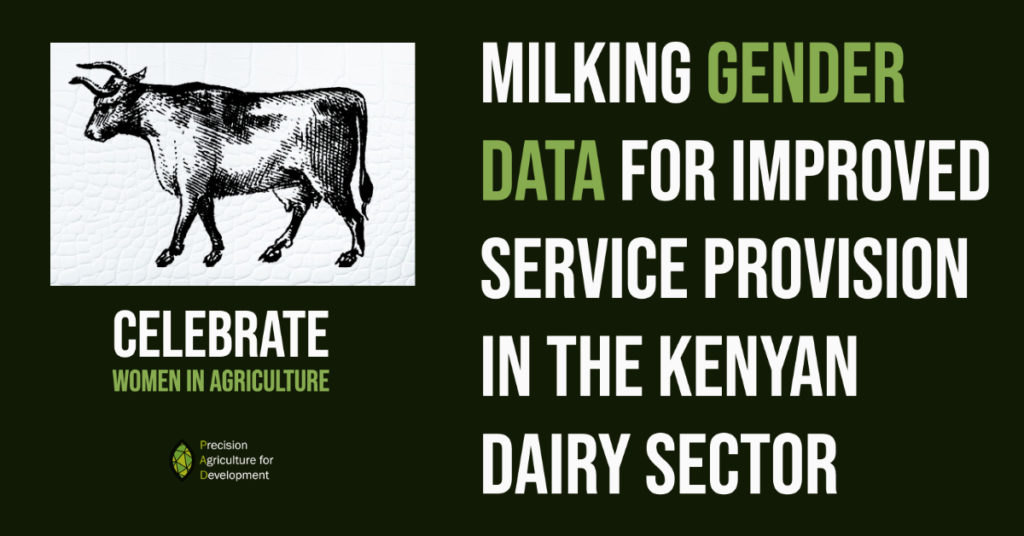
PAD empowers smallholder farmers across the developing world with actionable information to improve their wellbeing. However, there is evidence that digital advisory services like ours are underused by women. This summer we are expanding our agricultural advisory service in Kenya to the dairy sector, an arena in which women play a central role. As we prepare to launch, we are looking beyond one-size-fits-all solutions to more effectively address the unique needs, preferences, responsibilities, and constraints of female farmers.
This post is the first of two about a survey we are conducting in April 2021 to better understand gender roles and power dynamics in Kenyan dairy production and to better target our new service to the underserved needs of women in this sector. Here we describe the motivation and design of this survey. In a follow-up post, we will share insights from the results.
Invisible Women Farmers
In her spectacular book Invisible Women, Caroline Criado Perez details case after case in which service providers failed to deliver because they neglected to collect data about female users’ specific needs, preferences, and priorities.
The book cites the example of an organization seeking to provide “improved” seeds for staple crops: Male farmers cared more about increasing outputs. Women farmers, on the other hand, were more concerned with their input of time and labor in the field and in cooking the staple for household consumption. Since, adopting this new technology would require those doing the planting — women — to increase their time and effort, the seeds were not adopted.
Women often have less agency in agricultural and household financial decision-making. This is illustrated by Criado Perez who cites two failed attempts to introduce clean cookstoves capable of significantly reducing women’s exposure to toxic smoke. A model promoted in India required regular maintenance, which was considered men’s work. Since the new stoves improved women’s health, but didn’t directly affect men, stoves often fell into disrepair for want of maintenance. In Bangladesh, the fact that the clean cookstoves did not directly improve men’s outcomes, meant that they were not purchased at all, as men controlled household finances.
Understanding Context and Culture
Dairy is a sector of agricultural production in which tradition and gendered labor run deep. As we prepare to roll out our new advisory service, we commenced by focusing on a series of questions we need to answer to understand labor and decision-making dynamics in the sector, and within smallholder households more generally. These include:
- Who performs which tasks in the household, and within dairy farming specifically?
- Who holds the authority to make decisions?
- How systematically do users think about farming and what level of knowledge do they have about dairy farming? Does this differ by gender?
- Who controls household finances and for what types of purchases, and which accounts do they use?
- To what degree do women and men communicate about decisions and trust each other to make decisions in the interests of the household, even if one is the final arbiter of a particular decision?
The phone survey we designed to collect this information is due to be deployed in the field in early July, and will be asked to pairs of spouses. The goal is to obtain information to enable us to better target our services to both genders. By asking both men and women within the same household the same set of questions, we will be able to learn about typical responses for each gender, and we will also be able to note whether there are some questions for which we receive vastly different responses from a husband and wife within the same household.
Our survey will consist of six sections:
- Household Tasks and Time Use: This section will collect information about the gender(s) and age(s) of those performing various household tasks, including crop farming, livestock grazing, and water fetching. This section also attempts to account for household members’ time spent on other tasks, such as jobs outside the home and schoolwork. Information arising from this section will allow us to measure, for each time-use category, whether an activity is primarily performed by men, women, girls, or boys, or a combination thereof.
- Dairy Tasks: This section is similar to the Household Tasks and Time Use section, but focuses specifically on dairy farming, since the research team is most interested in using the results of this gender survey for informing the design and distribution of dairy advisory messages. This section will allow us to measure whether the following dairy tasks are primarily performed by men, women, girls, or boys: cleaning milking equipment, observing animals, giving cows water, feeding cows/calves, milking, milk transportation/sale, cleaning the housing unit (if zero-grazing or semi zero-grazing), sourcing/threshing fodder, spraying/dipping (for tick prevention), deworming, seeking veterinary treatment / artificial insemination (AI) services, identification (ear tagging), debudding/dehorning, hoof trimming, and grooming.
- Scenario-Based Questions: These are questions for which answers seek to understand respondents’ critical thinking abilities. An example of such a question would be: “Mrs Choge realized that to boost milk production beyond 7 litres a day, she needed to give her cow sufficient concentrates. For every 1.5 litres of milk above 7 litres, she gave 1 kg concentrate. How much concentrate should she give a cow producing 10 litres of milk per day?” We will disaggregate the results by gender to determine whether, on average, men or women think more systematically about dairy farming. This type of question tests the respondent’s causal reasoning, logical deduction, and systematic planning.
- Knowledge-Based Questions: This section is similar to the scenario-based section, but instead tests respondents on their technical dairy knowledge. As in that section, these questions have correct answers, and we will disaggregate the results by gender to determine whether, on average, men or women have more technical knowledge about dairy farming.
- Financial Decisions: This section will allow us to draw conclusions about who within the household holds financial power, with regards to purchases of productive assets, personal assets, and consumption goods. We will measure this empirically by collecting information, disaggregated by gender, on transaction amount as well as account type (digital/cash, joint/solo).
- Public Goods Game: In this section, respondents will be asked whether they want to augment the amount earned for participating in the survey by allocating a portion to a common account with their partner. A random amount will also be added to the survey by the research team, such that it is not possible for the respondent to lose money by completing this exercise, only to increase their earnings by a variable amount depending on the contribution made by both members of the spousal pair.1 This section allows us to collect data on trust within each spousal pair, which we assume to be correlated with the total amount contributed into the common account.
We plan to publish our findings to inform our own platform development and to make them available to other service providers and policy makers concerned with smart service design. In doing so, we plan to add to the existing body of research on gender and international development — a more complete review of which was published by my colleague Theresa Solenski in an earlier blog post.
Surveying the Evidence
Specifically, our research will add to the empirical evidence base on asymmetric information within the household. One study in Ghana found that on average, both men and women commonly underestimate or overestimate their spouse’s expenditures by more than 75%. Concerningly, this research found implications for profitability: the more imperfect the husband’s information about his wife’s expenditure, the lower the wife’s output/profit, and vice versa (Chen & Collins, 2014).
Another study from Uttar Pradesh provided an example in which women were less likely to adopt productivity-enhancing technology (in this case, laser land-leveling because they were less aware of its impact (Magnan et al. 2015)). Similarly, a study from Uganda in which agricultural videos were shown either jointly to a spousal pair, or separately to one member, found that information was not shared within the household when just one member was engaged (Lecoutere et al. 2019). These examples are particularly relevant to our work at PAD, as they highlight a way in which our service has the potential to fail: if our messages primarily reach men but women are charged with implementing the recommendations we provide (or vice versa), the suggested practices may not be adopted because we failed to get the information into the hands of women who can make it actionable.
Our survey will contribute to the literature on within-household asymmetric information in two ways. First, the sections on household tasks / time-use, dairy tasks, and finances will — in addition to providing information about gender roles — enable us to compare directly the wife’s knowledge of household affairs to that of her husband (and vice versa). Second, the sections quizzing respondents on dairy knowledge and testing of systematic thinking through scenario-based questions will measure within-household information asymmetries with respect to dairy farming.
Imperfect communication and limited trust also have implications for message adoption: Qualitative evidence from a focus group discussion with 113 male farmers and 141 female farmers in Malawi suggests that men often do not trust agricultural information received from their wives, and female farmers may be hesitant to suggest new agricultural practices for fear of retribution (Ragasa et. al., 2019). Another group of researchers partnered with Kakira Sugar Ltd., a large sugar company in Uganda that sources sugarcane through contracts with smallholder farmers, the vast majority of whom are men. This study implemented an intervention in which men were encouraged to transfer uncontracted blocks of sugarcane to their wives. Since both spouses needed to agree to the proposed intervention, whether the men were willing to do so provided in and of itself a measurement of trust. The researchers found a man was less willing to transfer the contract — i.e. was less trusting of his wife’s capabilities in this respect — if the household had fewer assets and/or expenditures, if his wife was not already involved in sugarcane farming, or if he had previously expressed a preference for managing the household’s finances himself (Ambler et al., 2021).
In our survey, we plan to collect novel data on trust within the household using the public goods game. Ambler et. al. applied a similar approach in their baseline survey, and collected time use data. They found that cooperation in the public goods game significantly predicted a husband’s willingness to transfer the contract to his wife, but time-use data collected did not have the same predictive power.
Finally, by collecting information on respondent demographics and knowledge alongside information about financial decision-making and intra-household communication and trust, our survey will add to existing literature about factors that influence bargaining power within the household. For example, a descriptive analysis of a Tanzania spousal dataset shows that a woman’s age, health, labor hours, and education were positively correlated with her authority to make decisions in the household; however, the number of children she had and her husband’s community standing were negatively correlated with this authority (Anderson et. al., 2017). In our survey, we plan to collect information on each respondent’s age, education level, and number of children, which we can use to disaggregate responses about financial decision-making and the amount contributed to the collective account in the public goods game. This will allow us to investigate whether factors similar to those observed in Tanzania hold weight in the Kenyan context.
Next Steps
We plan to begin the survey in early April and will interview approximately 600 dairy farmers via phone, over two rounds.2 We will first survey 300 respondents from dairy cooperatives, during which we will ask about contact information for their spouses. We will then complete a second round with the spouses of the first round participants.
The sample for the gender survey was constructed to select a representative sample for the two cooperatives interested in partnering with us for this survey, Sirikwa Dairies and General Limited and Katheri Dairy Farmers Cooperative Society. We chose these two cooperatives because they represent the two primary dairy producing regions in Kenya, and because they were able and willing to provide demographic information for their membership sufficient for us to stratify the sample by gender, total production, and total deductions on member accounts for expenses such as agrovet purchases, artificial insemination, veterinary services, and cash advances. This information will enable us to research intra-household gender dynamics for farmers of different levels of farming sophistication.
We expect this research will yield important insights, and we plan to publish the results in a subsequent blog post. The most important outcome, however, will be to improve our content and message delivery for the dairy farmers we serve.
_______________________________________
1. This approach has the added benefit of preventing the respondent from obtaining exact information about his/her partner’s contribution. We recognize that particularly female respondents may fear retribution if her partner were to discover her contribution and deem it insufficient. Our contribution is intended to prevent this outcome.
2. This number was arrived at using Cochrane’s (1977) formula with a margin of error 7.5% and confidence interval of 95% (both commonly accepted levels) to come to the following sample size of households for each dairy: 148 in Sirikwa and 145 from Katheri. Multiplying both numbers by two, we arrive at a minimum sample size of 586, which we round up to 600 for simplicity..
Theresa Solenski, PAD Global Research and Program Associate, reflects on the growing body of gender-focused evidence – generated by the field at large, and by colleagues at PAD – we can exercise to inform evidence-based interventions to improve the lives of women.
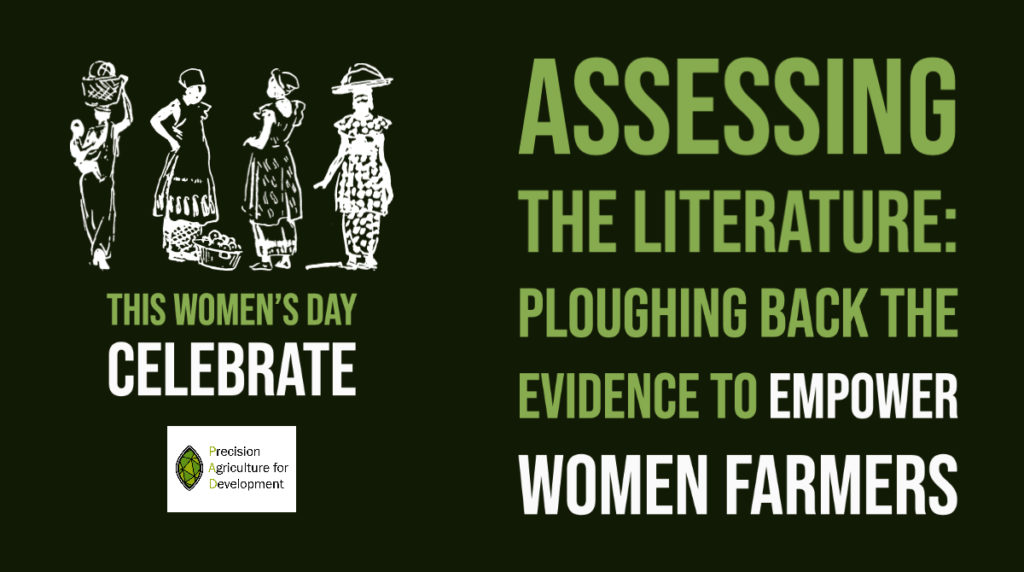
As we mark International Women’s Day, this blog post will reflect upon and celebrate the growing evidence-base of gender-focused research that is intended to inform evidence-based policies and laws to improve the lives of women. Experimental interventions and gender-focused surveys help to illuminate the unique barriers women face as women and reveal which solutions are most impactful for empowering women and reducing poverty. These interventions and their learnings provide a foundation for future policy work wherein positive impacts are replicated and iterated to benefit women in other contexts.
Much research has already been done at the intersection of gender and agriculture in developing countries, some by my colleagues and collaborators at Precision Agriculture for Development. Researchers know that women farmers confront various constraints (for example, constrained access to land, inputs,and finances) that are significantly different and usually more onerous than those faced by their male counterparts. Addressing these constraints can unleash significant agricultural productivity, to the benefit of households and communities more generally. For example, researchers know that women under-invest in plots when their land rights are not secure. In a study of a land tenure regularization program in Rwanda, investments in soil and water conservation (which are critical given the intensive use of land in Rwanda) increased by approximately 10 percentage points for male-headed households, but for female-headed households, these investments increased by almost twice as much (Ali et. al., 2014). One policy implication we can draw from this research is that strengthening women’s land rights can lead to larger per plot investments.
We also know that there is significant evidence that women face labor constraints when it comes to their agricultural productivity. Contributing factors include cultural norms which dictate that women should tend to children and the home, and constraints on women’s access to finances to hire labor or access labor-saving technologies (such as machines or animals). These types of gendered labor constraints can impact policy to the extent that some well-intentioned gender-sensitive interventions have had the negative effect of increasing women’s time poverty (Quisumbing & Pandolfelli, 2010). Taking these considerations into account, female-targeted interventions will be most productive when they focus on high impact behaviors and practices – those that produce significant gains in productivity with little or no increase in labor intensity.
Other research has focused on complicated intra-household dynamics that play a role in the empowerment and wellbeing of females in male-headed households. In particular, while women play a significant and active role in agricultural production, data reveals that they exercise decision-making authority on fewer activities than male-heads of household. An example is that husbands often make financial decisions without consulting their wives. Due to cultural norms, men are also often the ones who go to the market to both buy agricultural inputs and sell crop yields. This household dynamic frames an environment in which women are both unable to exercise decisions that impact their standard of living, and are unable to capture many of the gains associated with their labor despite their significant – often disproportionate – contribution to household production.
Interventions that target women with agricultural extension services can increase their agricultural decision-making ability in the household. A study of maize farmers in Uganda found that women who received agricultural information (either alone or jointly with their spouse) reported large, statistically significant increases in their decision-making ability (Lecoutere et. al., 2020). The same study found that in households where women were involved in receiving agricultural extension advisory, adoption and input use indices were statistically larger than those in the control group.
Moreover, research demonstrates that increasing women’s decision-making ability in agricultural tasks can lead to improved wellbeing. A study of dairy farmers in Uganda found that greater decision-making input on the part of women farmers into dairy production reduces women’s time poverty. The researchers’ model shows that women’s input in dairy production was likely to reduce women’s time poverty by approximately 97 per cent when they had some input (Bain et. al., 2018). This evidence is encouraging, and suggests that not only can agricultural information empower women farmers by increasing their decision-making abilities, but that this empowerment can improve productivity and wellbeing.
PAD functions both as a research generator and as an implementer of gender-focused learning. For example, PAD has developed a gender survey which measures time-use, financial decision-making, and gendered task-allocation among dairy farmers in Kenya. The survey deploys an innovative public goods game which is played by spouses as means for measuring trust and communication, and to reveal intra-household dynamics. The findings from this survey – which is currently being implemented – will be used to inform our Kenya dairy program, other programs like it, and will contribute to the literature on the influence of gender in dairy farming.
In its role as implementer, PAD has developed content to specifically address the needs of female farmers and we mass-disseminate this content via mobile phones. For example, in Odisha, India, we send messages focussed on the cultivation of kitchen garden to approximately 60,000 women. These messages cover content on crops in a domain that is typically under a woman’s decision-making purview. Messages were field-tested with women focus-groups and the advisory highlights the benefits of maintaining a kitchen garden, compost preparation, cultivation of crops, pest and disease management, and the nutritional value of kitchen garden crops. Our kitchen garden messages have received higher ratings than our regular Ama Krushi messages (4.2/5 vs 4/5) and women have indicated a strong preference for the kitchen garden content (87 percent of women reported a preference for the kitchen garden content over the traditional Ama Krushi messages).
Much work remains to be done. One challenge we face is to effectively target and communicate with female farmers through mobile phones. Globally, women are less likely to have access to the internet, to own their own phone, and to be literate (OECD, 2018; Baroni et. al., 2018). In order to effectively reach women, mobile interventions must be sensitive to these constraints, providing resources in mediums that women understand (for example, voice services rather than SMS and using local dialects where applicable). A further complicating factor is that many smallholder households only have one cell phone with all adults in the household sharing one device. As a consequence, the gender of the person on the receiving end of our service is often unclear. This can result in gender misclassification wherein the person who registered with our service is not necessarily the same person who engages with the platform. Moreover, PAD currently collects gender-related data in only half of its programs. However, we are committed to collecting gender data from all programs where feasible and to conduct quality checks when gender misclassification is suspected.
Experimentation and heterogeneity analysis inform our gender programming in contexts where we have gender data, and this allows us to iterate evidence-based programming to make it progressively more impactful in women’s lives. For example, in Uganda, PAD’s team has used A/B testing to more effectively understand whether matching the gender of the narrator’s voice [in an automated IVR call] with the gender of the recipient increases engagement with the platform. Results indicated that women listeners who switched from receiving calls with a male narrator to a female one, were almost 2 percent more likely to complete a call. Based on this evidence, future content in Uganda will be narrated by women.
We plan to continue on this path forward: leaning into the literature for guidance while generating and iterating the evidence-base through the use of A/B tests; focusing on developing and delivering high-impact content; improving intra-household coordination; and more effectively identifying and leveraging high-opportunity channels to communicate with women.
Maya Woser, Senior Research and Operations Associate, Stefania Pozzi, Global Senior Research Associate, and Yifan Powers, Global Senior Research Associate, pull on strands of evidence to assess the effects of patriarchal practices and cultures in the workplace and the effects of empowering women as role models and leaders, and concurrent effects for organizational development. The piece also integrates reflections from PAD colleagues Maureen Kuboka, Caitlin McKee, Claudia Carbajal Morelos, Sam Carter, Wafa Tahir, Maham Bokhari and Owen Barder.

Whether you live in the United States or India, the past 12 months have been a difficult time for women. The COVID-19 pandemic laid bare and exacerbated many structural inequalities and barriers that continue to make it difficult for women to fully participate in the workforce. It also highlighted the indelible value of women’s reproductive labor, which, in many respects, is the often invisible and unpaid work that allows our global economy to function. This is especially true for traditionally marginalized groups, as evidenced by the outsize impact of the pandemic on women of color in Western societies, and highlights the importance of intersectionality when thinking about how each society can best support women and families. Yet while the pandemic has shown how tenuous our progress in gender equality can be, it can also provide the momentum for profound change. As Arundhati Roy wrote, “the pandemic is a portal, a gateway between one world and the next” and we can take this opportunity, when everything seems broken, to move toward a new reality. In that spirit, and in honor of International Women’s Day, here are some reflections from staff at PAD on what factors, especially in the international development field, are important to consider when building a more gender equitable future.
Role Models
In a now seminal paper, Lori Beaman, Nobel Prize in Economics winner, Esther Duflo, Rohini Pande, and Petia Topalova found that while increasing the number of women in leadership positions in India did not impact structural labor market opportunities for young women, there was a strong, positive role model effect on young women’s perceptions of self-worth and the types of roles they could inhabit. The co-authors also found that increasing women representation in visible leadership positions changed the perception of others’- in this case parents – with regard to what girls can accomplish.
Beaman et al’s paper describes through rigorous experimental data an experience many women are personally familiar with – the profound impact of seeing women in positions of power and in positions they may not have been able to imagine themselves in before. In the workplace, particularly in traditionally male-dominated STEM professions such as economics, this means increasing the visibility of women through hiring, promotion, and keeping them in the workforce – not just in a few token leadership positions but systematically throughout an organization – can be crucial to closing the gender gap. Advancing gender equity is always going to be a work in progress and in the spirit of transparency, PAD can report that 40% of our current staff overall are women and about half of our management roles are occupied by women.
Reflections from PAD Staff
Maureen Kuboka, Agronomy Associate, PAD – Kenya
Why do you think having women as role models is important in the agronomy field?
It is important to have female role models in agronomy because they help you know that you can succeed in this male-dominated field. A role model or mentor can hold your hand and help you know how to make it. In my experience, they have challenged me and shown me that it can be done.
Have you ever had a woman as a role model or mentor, whether formal or informal, who impacted you in your career?
At my former workplace, I was inspired by the success of several senior female agronomists. I took that opportunity to observe and follow in their footsteps through “observational learning”. I am also still in touch with two senior lecturers who are women from my postgraduate degree and several of my former college classmates. We encourage one another in our respective fields of work and I am particularly challenged by college classmates who have been able to scale the ladder as well as those pursuing further education while they work. I am also keen to develop a formal relationship with a female mentor through the African Women In Agricultural Research and Development (AWARD) Fellowship.
How does having more women in the workplace make you feel about that workplace and does it change how you approach your work?
Having more women in the workplace makes me feel that women are being recognized and highlights how inclusivity is a powerful tool. It boosts my morale and feeling of having opportunities at work, as well as improves collaboration and teamwork. For example, I can comfortably share a personal issue with a female colleague and we can find a solution through discussing how they overcame a similar issue. I was elated by the recent appointment of Dr. Ngozi Okonjo- Iweala as the Directory-General of the World Trade Organization. She inspires me to picture myself as the next Director-General of the Food and Agriculture Organization of the United Nations (FAO).
Caitlin McKee, Global Research Support Manager
Why do you think having women as role models is important in academia/the development economics field?
As a woman, having a female role model in the workplace is important for your development, especially in navigating tricky decision points in your career trajectory like furthering your studies, switching jobs, or handling maternity leave. It’s also critical for shaping the lens through which you see your professional work. The perspectives of women, along with other minority perspectives, are critical to understanding the development economics field and identifying what kind of research questions to ask in the first place.
Have you ever had a woman as a role model or mentor, whether formal or informal, who impacted you in your career?
In graduate school at the University of Washington I worked for a research team led by Leigh Anderson and Mary Kay Gugerty. Despite incredibly busy schedules, these professors encouraged my learning, helped me develop critical skills, and pushed the bar of excellence for our work. There was also a gender-angle to much of the analysis that we did, not only on agricultural outcomes, but also on outcomes such as intra-household decision-making and time use, and they always emphasized the importance of gender-disaggregated data in any context. Their approach to crafting relevant research questions for women living in poverty reinvigorated me wanting to continue in the development field, using data as a tool to shed light on policy relevant questions.
How does having more women in the workplace make you feel about that workplace and does it change how you approach your work?
Workplaces are better with diversity of all kinds to bring different perspectives and experiences to doing the work itself and in setting organizational norms. Having more women in the workplace, especially in leadership and management positions, is an important part of that. At PAD I’m very pleased to get to report to our female Chief Economist and Director of Research, Tomoko Harigaya. Of the many reasons why I wanted to work for PAD, a solid group of women in leadership and management positions to work with closely was a very compelling reason.
Leadership
Despite progress in recent years in the number of women represented in leadership positions and in advances toward the achievement of equal opportunity, there are still strongly embedded gendered stereotypes about who a leader is. A study by Martin Abel found that both women and men react more negatively to criticism if it comes from a woman, and work by Gallup found that even women are more likely to report a preference for having a male boss compared to a female boss.
One explanation for these stereotypes may be actual differences in men’s and women’s leadership, but there is ongoing debate as to whether such differences exist. In a 2003 meta-analysis of 45 studies, Alice Eagly and Mary Johannesen-Schmidt found that women tend to use a more interactive style of management called transformational leadership, which emphasizes open communication, intellectual stimulation, and support for staff’s personal growth. The authors also found that women were more likely than men to deliver rewards to subordinates for appropriate performance. On the other hand, authors like Cliff, Langton, Aldrich and Andersen and Hansson claim that there are no significant gender differences in leadership styles. Another possible explanation is that these stereotypes originate from underlying beliefs, attitudes and mindsets about appropriate gender roles and behaviors: our expectations and gender biases might change the way we observe reality.
Either way, the presence of these stereotypes highlight the depth of challenges to women in leadership positions, especially those in traditionally male-dominated fields where the few women who make it to the top are often confronted with questions on their ability to lead. However, organizations can do a great deal of work that levels the field for women, principally by creating an environment that is free of discrimination and one in which talent can be evaluated on an individual basis and not according to latent gender stereotypes. This will not only grow the talent pool of potential leaders, but will also ensure that different perspectives are brought together to contribute to the multiple challenges society faces.
Reflections from PAD Staff
Claudia Carbajal Morelos, Regional Director for Latin America
What do you think are the most significant challenges that women leaders face in the development field?
Unfortunately and unsurprisingly, the challenges faced by women in the development field mirror those abroad in society. Here are three that are salient for me:
1. Credibility – I think when working with new people, women start out with a credibility deficit compared to their male peers. Women are placed with a greater burden of “proving” their credibility and need to exert more effort and be better prepared to earn an equal seat at the table.
2. Believing in yourself – Because society has conditioned women to doubt themselves more, or to exert less authority, women are more likely to caveat their perspectives or opinions. This can reduce the strength and effectiveness of their interventions. Women are also likely to question their qualifications when thinking of taking on new responsibilities. For example, men are more likely to apply to a position for which they don’t meet the criteria. Women are also more likely to volunteer for thankless or low-promotability tasks.
3. Speaking up – In my experience, women are less likely to speak up in meetings. This limits our influence and ability to recruit people to our ideas or initiatives.
Which piece of advice would you give to women who are trying to become leaders in the development field?
1. Find a mentor – Or find a few. Find people that share your vision and can help you advance your professional or personal goals. Recruit people that fully embrace your identity as a leader.
2. Be aware of internalized gender biases and how those affect your actions – It can be easy to fall into stereotypical attitudes or roles and it can be hard to identify those situations or actions. Find good resources that could help you understand what you are doing and how to change those behaviors. Be intentional with your actions and reflect on them frequently.
3. Trust yourself – Believing in yourself and your strengths is fundamental to applying your full self to your work. Identifying your weaknesses and working on them can be helpful, but don’t let that become your entire self-identity. Pay equal or greater attention to your strengths and leverage them widely.
4. Promote dialogue and diversity training in your workplace – Unfortunately, you don’t have control over how others’ biases affect you and you, alone, can’t change their net effect on your work. Actions on an individual level help, but action at an organizational-level is important to reduce the negative effects of bias.
Who inspired you and why?
I find Michelle Obama inspiring. She is a self-confident woman who stands up for what she believes in. She has fantastic communication skills that empower her to deliver complex messages to broad audiences. She is charismatic and has a strong character. She is perseverant and stubborn, while also compassionate. She is both privileged and well-grounded. She is relatable and accessible. I wished the world had more Michelle Obamas.
I was also inspired by Patricia Bellinger, a professor I had during graduate school. She teaches “The Art of Leading in a Diverse World” and included a lot of sessions on gender. She helped reshape my understanding of identity and gender and taught me how to move from micro-inequities to micro-affirmations.
Sam Carter, Global Research and Operations Manager
As a development practitioner we may often be working in contexts where the conversation on gender equity is just starting to gain traction. How do you balance incorporating a gender equity focus in your projects and advancing your project’s specific outcomes, which may be complicated by a gender lens, in those contexts?
To design a program that achieves a specific set of outcomes in any given context, we first need to understand the impediments preventing people from achieving those outcomes in the first place, and recognize that different groups face different sets of impediments. Conducting qualitative research to understand the barriers facing each group, and doing so in collaboration with local practitioners and researchers, should be a key part of designing any new project. Of course, gender is never the only source of inequity, so developing an understanding of the ways that other issues (caste, race, socioeconomic status, etc.) intersect with gender-related issues is a crucial piece of incorporating a gender lens.
For practitioners and researchers who would like to incorporate a gender lens in future work, this resource from my former colleagues at J-PAL offers practical guidance on measuring women’s empowerment and agency.
What leadership qualities do you think are important in your field and why?
I think empathy, humility, and compassion are crucial for effectively working across contexts and for being able to learn from others. Most of us who work on issues related to poverty reduction got started in the field because of a desire to improve the world and address inequality at some level. Leaders who embody that mission are able to inspire their colleagues, recognize their blind spots, and make space for all voices to be heard. It’s also important to be a clear and proactive communicator about both project-specific things like deadlines and deliverables, as well as big-picture strategy and vision.
Have you ever struggled as a woman to be seen as a leader? How did you work through those situations?
I’ve worked in a handful of environments where men’s voices were elevated and trusted at the expense of women’s voices, and where structural problems were ignored by defining the primary issue as being one of women lacking confidence. In those situations, I focused on noticing and writing down specific examples of how these biases were detrimental to the goals of the organization or project. I’ve also learned that leadership is more likely to take action on an issue when it is presented alongside a set of potential solutions. I worked with colleagues whom I trusted to come up with options that would be both impactful and feasible for the organization.
Overall, however, I’ve been privileged to spend most of my career working in organizations where women are given plenty of leadership opportunities, and to benefit from the mentorship and friendship of many incredible women (including the authors of this blog)!
Organizational Robustness
In both the private and public sectors organizations are increasingly turning to a “business case” for gender diversity. However gender diversity isn’t something to pursue for the sake of impressive statistics in annual reports, it is an organizational value that can strengthen teams and organizations. For example, research has shown that diversity, including gender diversity, at the leadership level is correlated with better financial performance. This may be because heterogeneous groups challenge each other and are more innovative, hence why “diverse teams are smarter.”
Within the field of development economics, there is suggestive evidence that women ask different research questions. Seema Jayachandran, inspired by a blog post by Rachel Glennerster who explored the critique of randomized controlled trials as dealing with “small” or less “macho” topics, looked at the percentage of women authors by topic in three relevant economics journals. She found there was some segregation in topics, including that women – unsurprisingly – tend to write more about gender and health. Women bring different perspectives to the research table, but the strength of these insights will reach their potential only if they’re given due consideration. This echoes research by Letian Zhang at the Harvard Business School: that the positive impact of gender diversity is only present in contexts where gender diversity is accepted and considered important.
To make diversity meaningful and continue to attract and retain diverse employees, organizations need to make structural changes to support that diversity. This is more salient than ever within the current COVID-19 pandemic, a time when shifts in work structures have led to an increase in working women’s, often unpaid, domestic and care work. This can, and has had, significant impacts on working women, especially mothers, across the world. For example, in the United States, an estimated one in four women is considering downshifting or leaving her job due to COVID-19, with a disproportionately negative impact on women of color. In many developing countries, women are primarily employed in informal sectors which have fewer social security nets and have been disproportionately hit by COVID-19. The pandemic and the associated increase in unpaid domestic and care work threatens to undo decades of progress in terms of women’s workforce participation.
Reflections from PAD Staff
Wafa Tahir, Research Associate, PAD – Pakistan
How has gender diversity affected your team or organization’s performance?
According to my past experience, working as the only woman on a team can be daunting and lead to multiple misunderstandings between team members. Being very new to PAD Pakistan, I experienced early on that gender diversity in the PAD Pakistan team has led to strong communication between the team members who support each other come what may, which in turn highly impact the team’s performance in a positive way.
Maham Bokhari, Research Associate, PAD – Pakistan
What does an inclusive workplace look like to you?
To me, the definition of an inclusive workplace is essentially about “cerebral equality.” This means that each person working for an organization is equal in all regards and subsequently will be offered equal opportunities, regardless of gender, age, race and religion. The only difference in each worker should be based upon the skills and cerebral knowledge that they bring to the table. I believe that inclusiveness for me shall rest on cerebral opportunities irrespective of any other parameters.
Wafa Tahir, Research Associate, PAD – Pakistan and Maham Bokhari, Research Associate, PAD – Pakistan
What factors from your experience make you feel supported and included as a woman in the workplace?
WT: The continuous help from my team members and their faith in my abilities make me feel included and supported. Moreover, at PAD, the support of our Management team, by acknowledging my work and giving me individual importance, has made me feel that my voice is heard and my opinions are important.
MB: Having worked in the public sector, I realized that being the only woman in large meeting rooms can often be unnerving. In such settings, women have historically been considered less “influential”. However, working as a young, aspiring woman at PAD, I have been offered immense support and guidance from fellow men and women in my team. Furthermore, my ideas, words, opinions and input has been valued at an equal weightage in meetings, as well as during routine working sessions.
Owen Barder, CEO
How has gender diversity played a part in your organization or team’s “performance”?
I’m passionate about gender diversity because I think creating an inclusive workplace is the right thing to do. It is also very good for the organisation, in at least four ways:
- Widens our talent pool: By recruiting and retaining women, we benefit from the skills and expertise of half the population.
- Broadens our perspectives. We benefit from the different points of view and it helps to understand the people we aim to serve. By making PAD more inclusive internally, we can do a better job of increasing inclusiveness and equity in the communities we serve.
- Builds better teams and improves organizational culture. In my experience, gender diverse teams collaborate better, are less macho, more supportive, and less competitive. Diverse teams tend to be more emotionally intelligent and draw the best out of all staff.
- A more inclusive workplace enables us to retain talent. Many organisations underestimate the costs of staff turnover in terms of lost expertise, the pressure caused by vacancies, and the cost, effort and risk of recruitment. By paying attention to inclusivity, we are more likely to keep more of our excellent staff.
What policies make a difference?
We need to listen carefully to staff members about what they think is important for creating an inclusive workplace. Some themes I have learned are important are:
- Fair and equal compensation – we are still in a world in which women are often paid less than men. We need to address this head on, by ensuring that salaries and benefits are set in a fair and transparent way.
- A culture of flexibility – recognising that different people have different commitments. We can offer flexibility in terms of working hours, location, working style and we can accomodate people who have to rearrange their work to deal with unexpected pressures (e.g. a school is closed). And we need to be disciplined about ensuring that discrimination does not creep in against those who exercise these flexibilities.
- An inclusive working culture – we must make sure that women are listened to and recognised in the workplace. Organisational culture can and does change, if people with power are self-aware and model good behaviour themselves.
- Tackling multi-dimensional discrimination – it is important to recognise that discrimination and privilege take multiple forms. Not just gender, but race, class, nationality, disability, sexuality, religion, physical appearance, and educational background can all affect a person’s opportunities. When we think about being more inclusive, we should be particularly thoughtful about the many different forms of discrimination that some people face and how these interact with each other.
- Role models, sponsors and mentors – by increasing the visibility of women in leadership roles, and supporting others to advance, we can ensure that women have more access to opportunities to advance their careers.
- Inclusive talent management – good leadership depends in part on spotting talent in the organisation and providing pathways for people to grow and succeed. Addressing biases in the way that talented colleagues are identified and supported can create a much more inclusive workplace.
How can we incorporate global values of gender diversity and equality while working within local contexts?
Precision Agriculture for Development is an increasingly global organisation that works in places with different cultural norms. I don’t regard these differences as a reason for us to equivocate on gender diversity – our sense of injustice about discrimination is the same for everyone everywhere; and our ambition to be fully inclusive is universal. Our commitment to being honest, humble and self critical should make us sensitive to differences across social contexts, but need not make us accept injustice.
As we create a more inclusive organisation, these differences may mean that we need to adopt different approaches to change in different places. For example, I recently took part in training on unconscious bias, intended to help me challenge my own perspective on inclusivity, which was organised here in the UK. The trainer had developed material which was particularly relevant for leaders in the UK. For example, class plays a much more prominent role in Britain than it might in other contexts, and that featured a lot in the training; while there was relatively little in the training about religion, which might have been given more weight in course for a different context. So while our ambitions are universal, differences between places might well lead us to conclude that particular problems are a higher priority in one team than another, or that we need to tackle problems in different ways from place to place.
In writing this post, a lot of what we learned reinforced what we already know: there is much work to be done. Just a few weeks ago, a New York Times piece reported on an upcoming research paper led by Pascaline Dupas and Alicia Sasser Modestino which studied the types of questions posed to economists at research seminars. They found significant evidence of gender discrimination and bias. Reading the comment section of the article, which was filled with similar stories of bias from women both within and outside economics, it’s clear this research affirmed an experience many women are all too familiar with. As development practitioners, we know that data is a powerful tool that can catalyze action, yet the data we need doesn’t always exist, as evidenced by the difficulty Dupas et al faced in further studying the experience of women of color in economics. It is therefore up to us all, using the strength of our diversity, to recognize what is missing and address it in our effort to build a more equitable future.
Make an Impact Today

